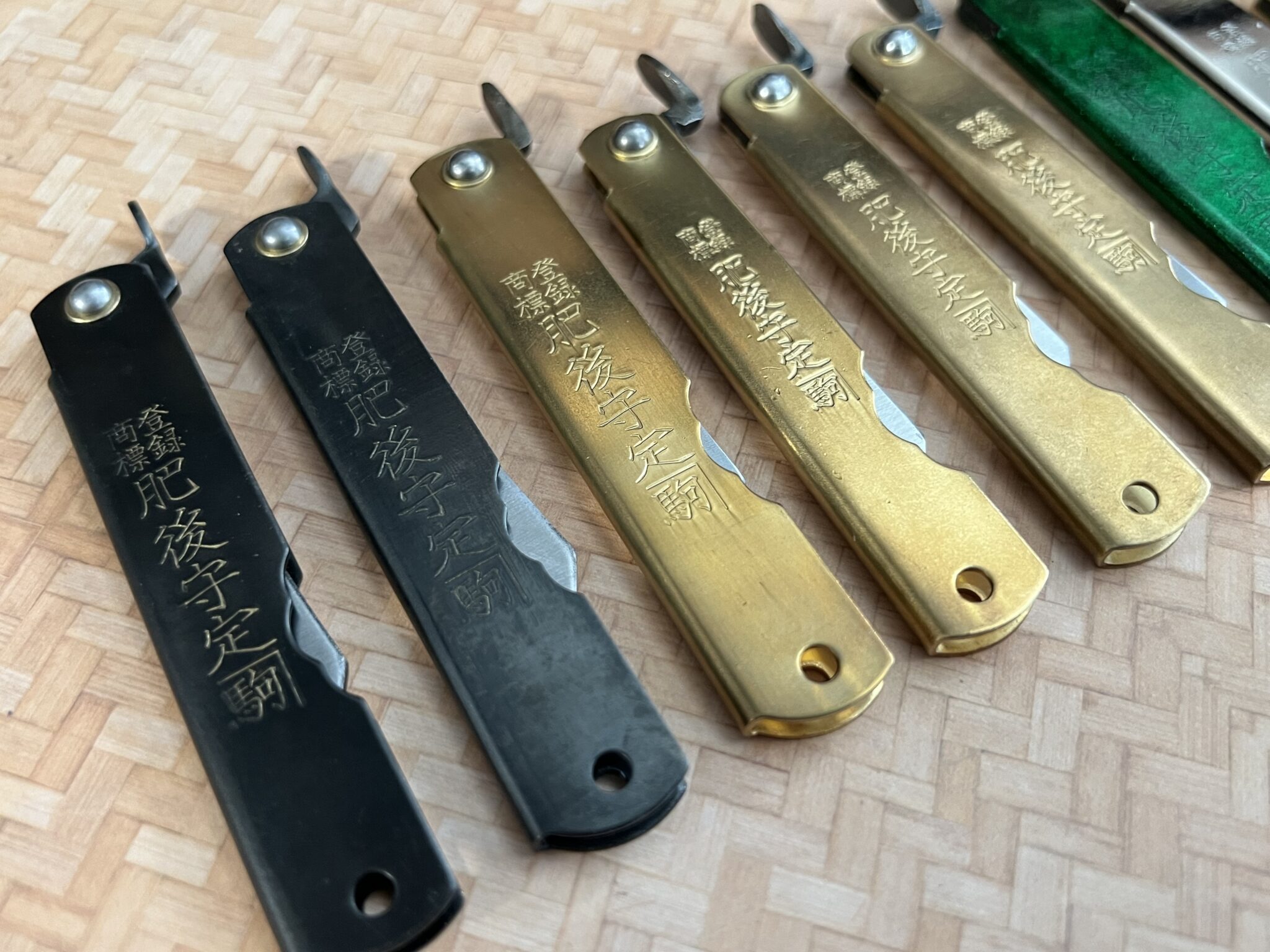
If you visit my tying desk, you’ll notice two gadgets that have taken up permanent residence on the base of my vise: my scissors, and a Higonokami knife. The former would certainly make sense at a tying desk. The latter might seem a little odd, yet it’s nonetheless just as utilitarian (and certainly more storied).
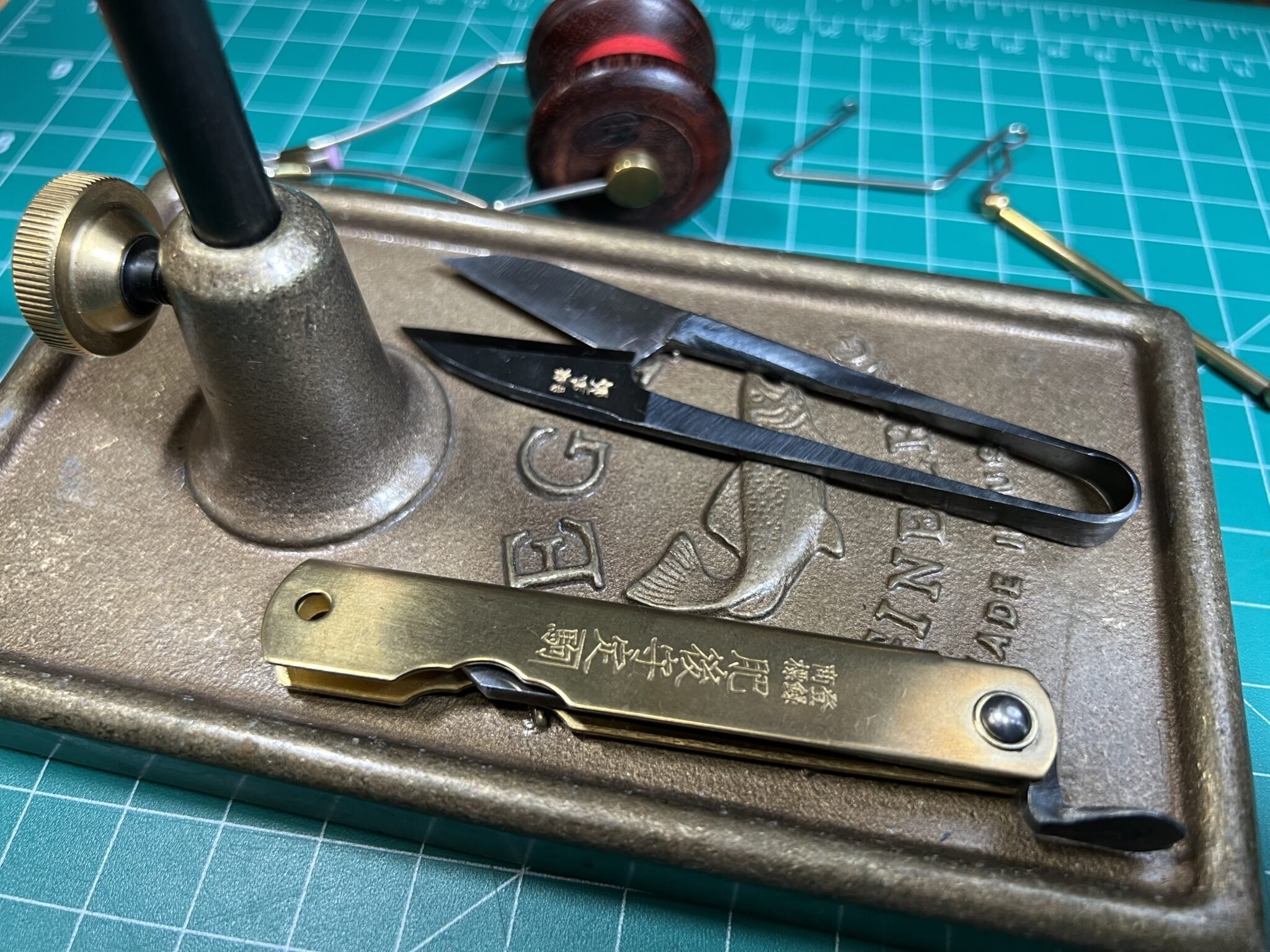
What is a Higonokami Knife?
Essentially, it’s a simple, yet very clever little utility pocket knife from Japan. Ask any Japanese person about the Higonokami and chances are, they own one, have owned one, or are at least aware of it by name. You might say that the Higonokami is to Japan what the Opinel is to France.
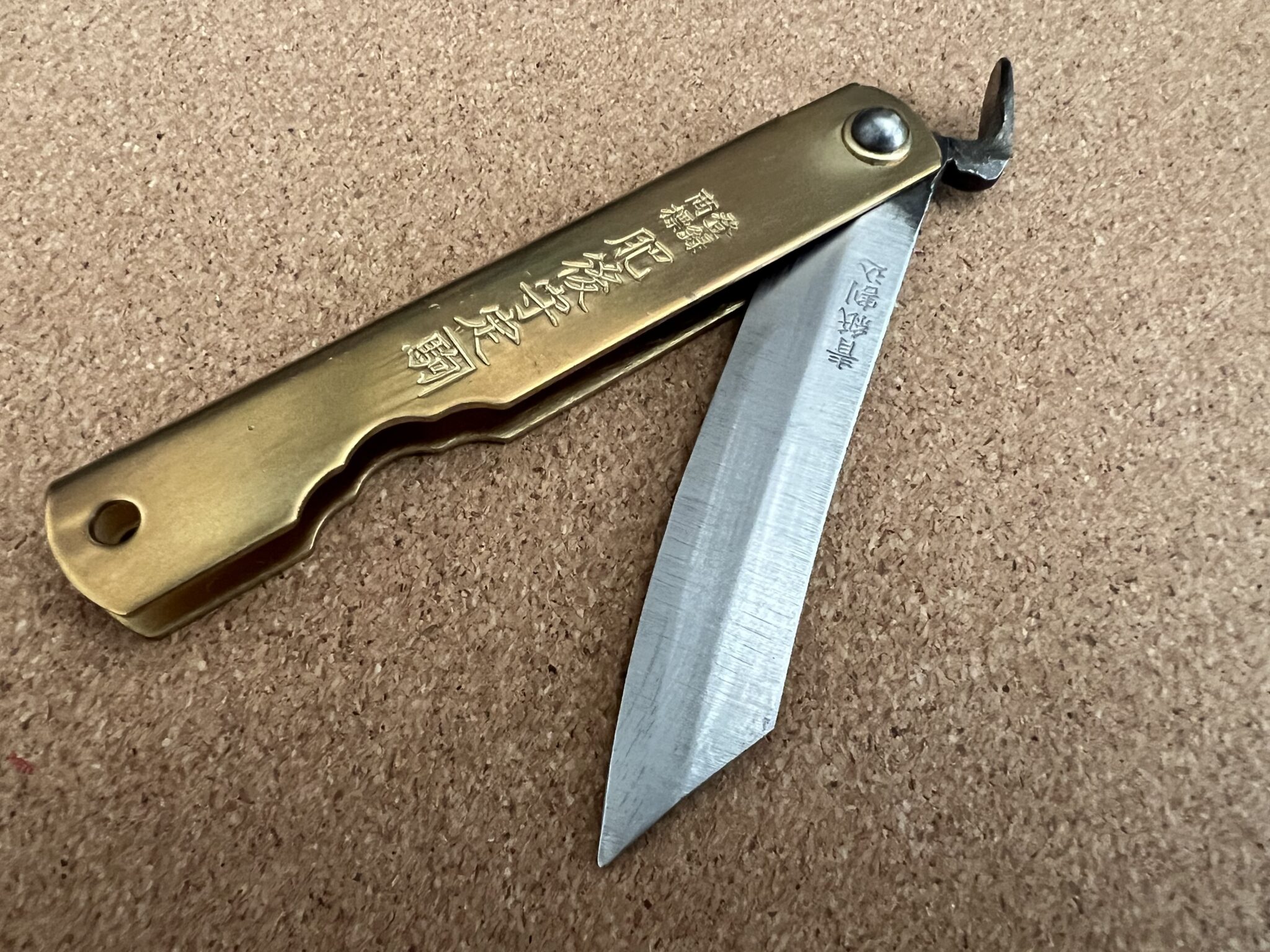
It’s opened by a little iron flipper at the end but it’s not what we would call a “flipper knife”–the kind that opens with one hand at lightning-fast speed like a switchblade. This is decidedly a two-handed open/close. Like tenkara, the lack of mechanical embellishments forces you to slow down and be more mindful when opening and closing it.
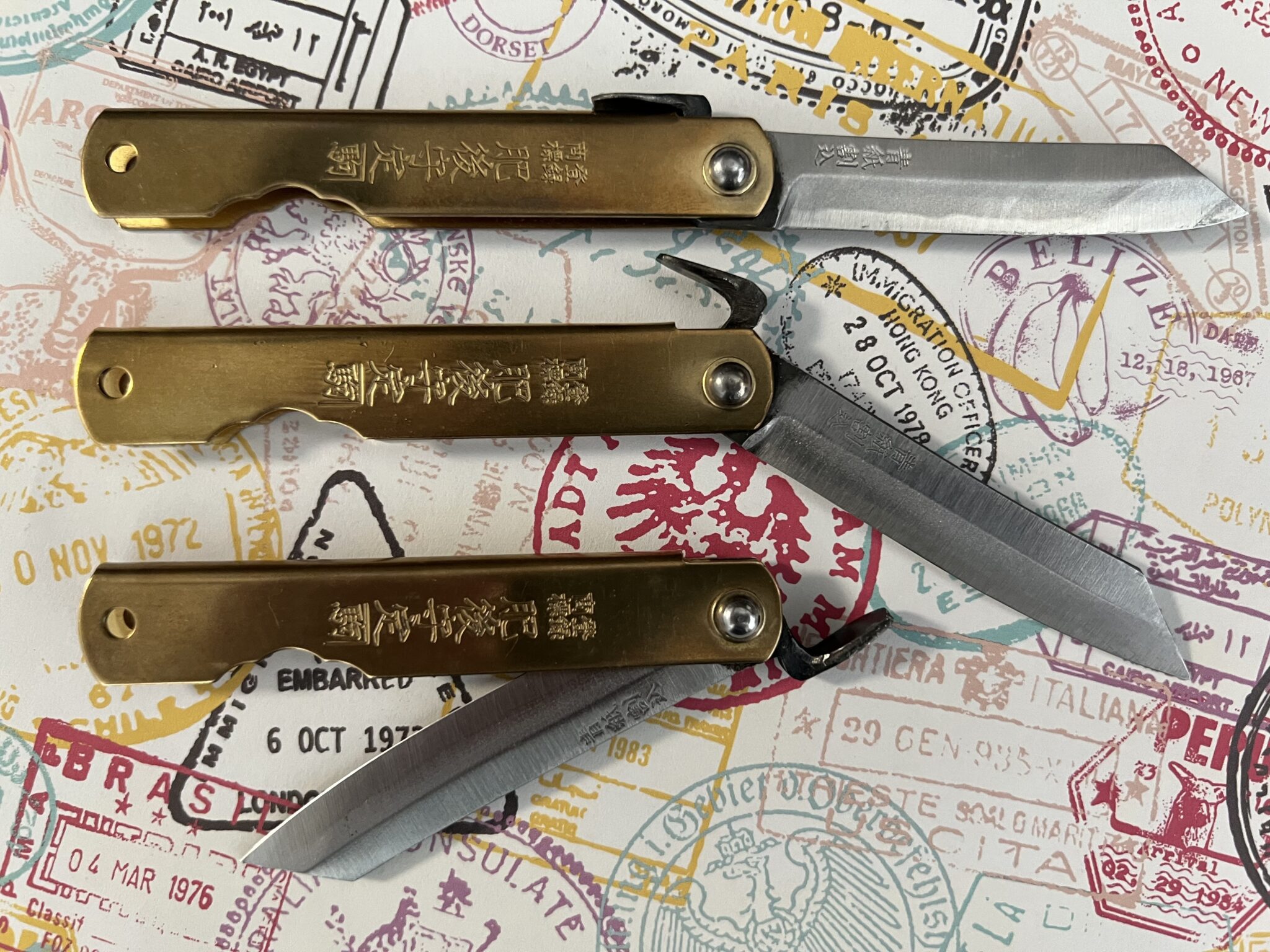
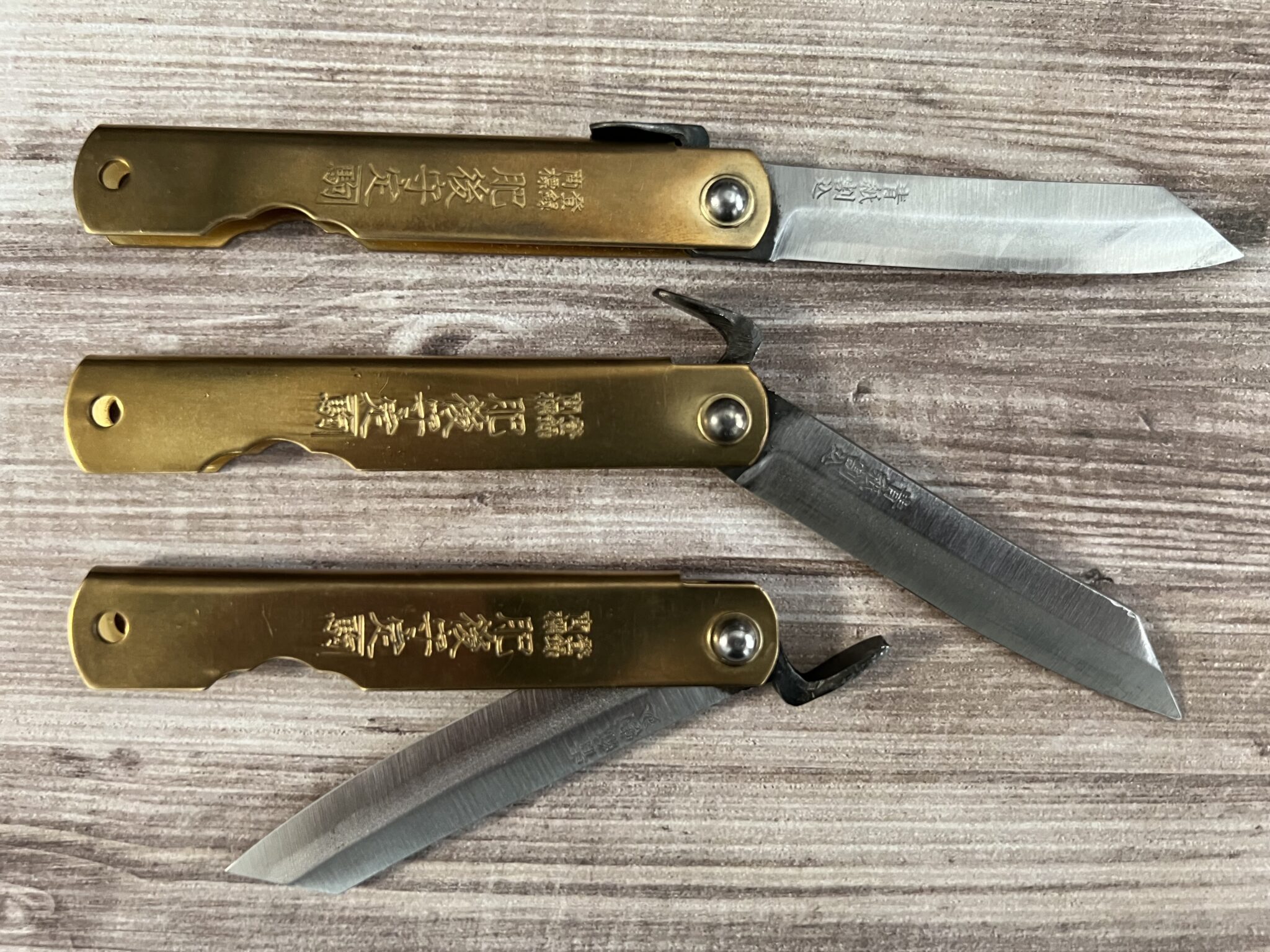
Aside from aiding in opening the knife, the “flipper” tab has two other benefits. Since there is no locking mechanism, when holding the knife, you press down on it with your thumb against the top of the handle to keep the blade from accidentally closing.
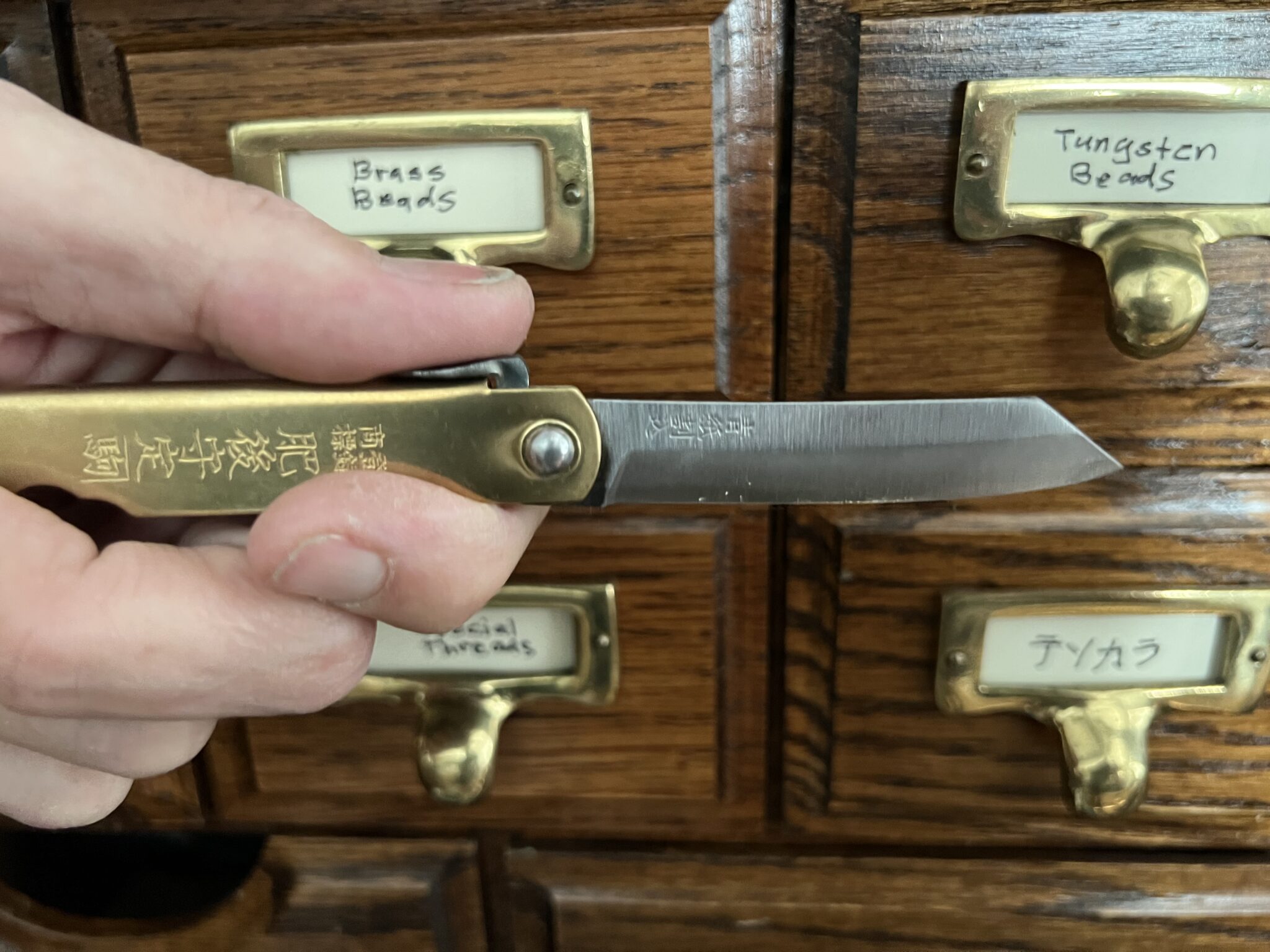
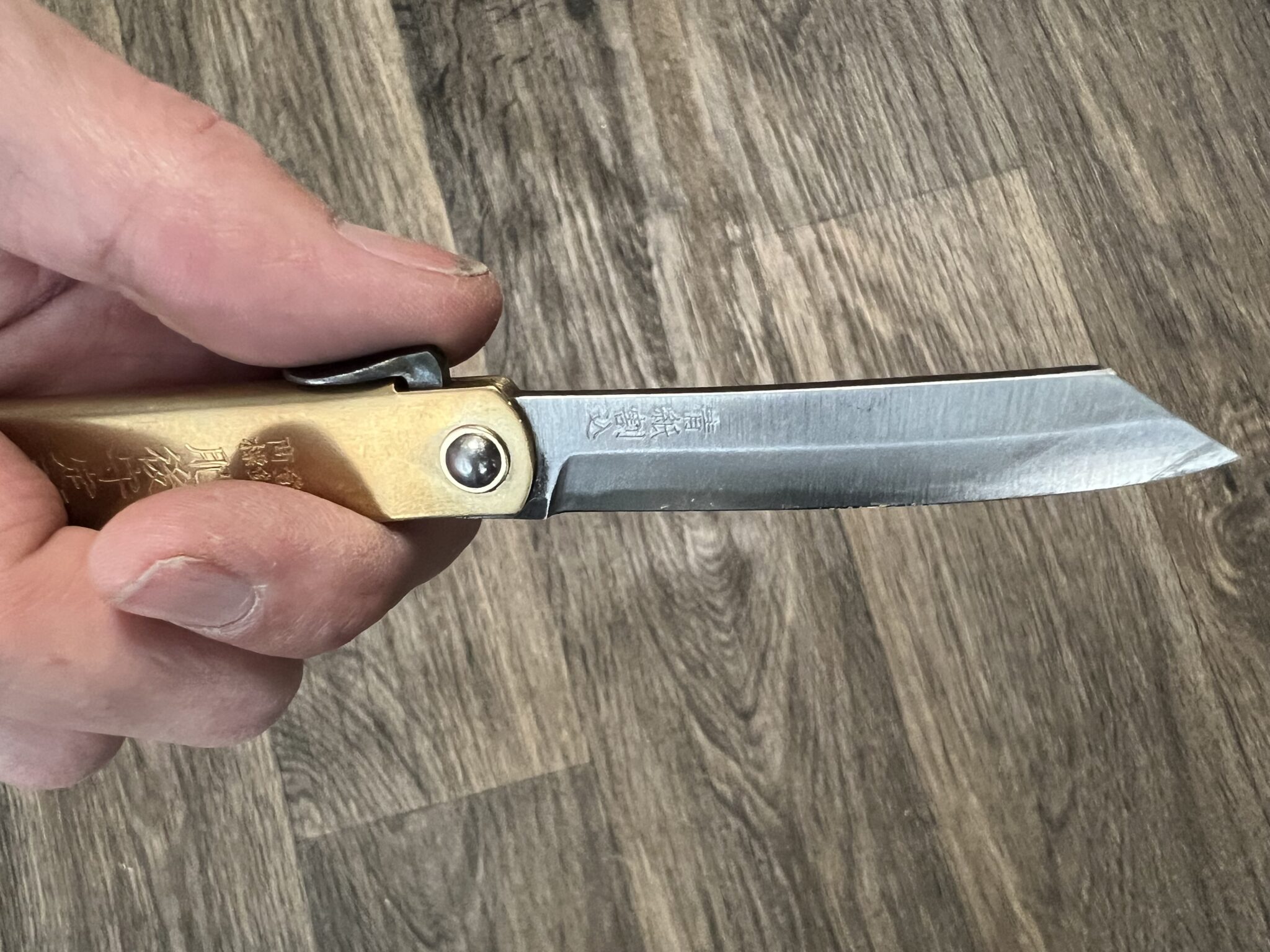
As you’ll notice, it’s a riveted design, meaning there is no adjustment on the the opening or closing inertia of the blade though I suspect you could tighten it up by squeezing the folded steel together. I haven’t tried it nor have felt the need to yet.
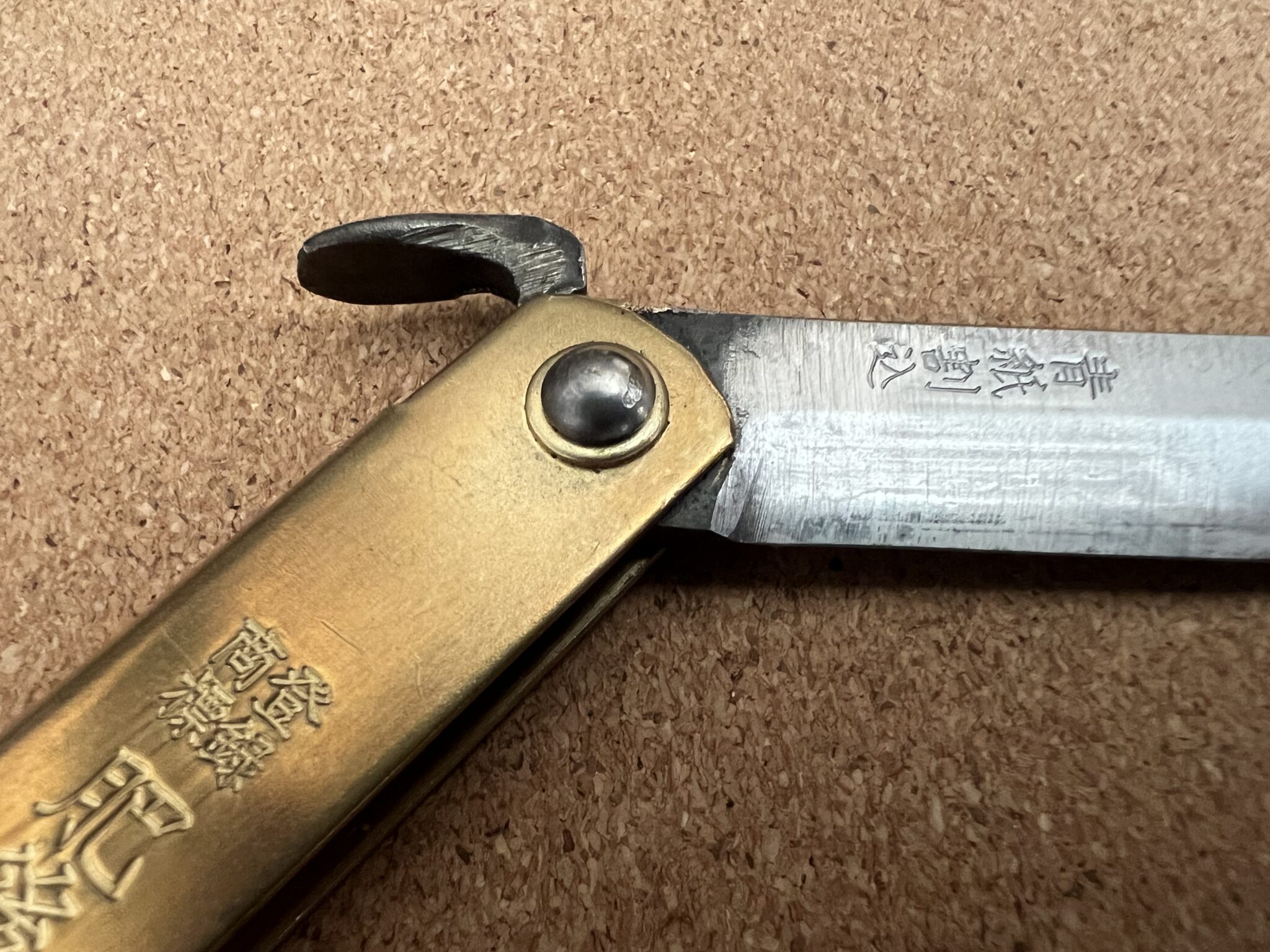
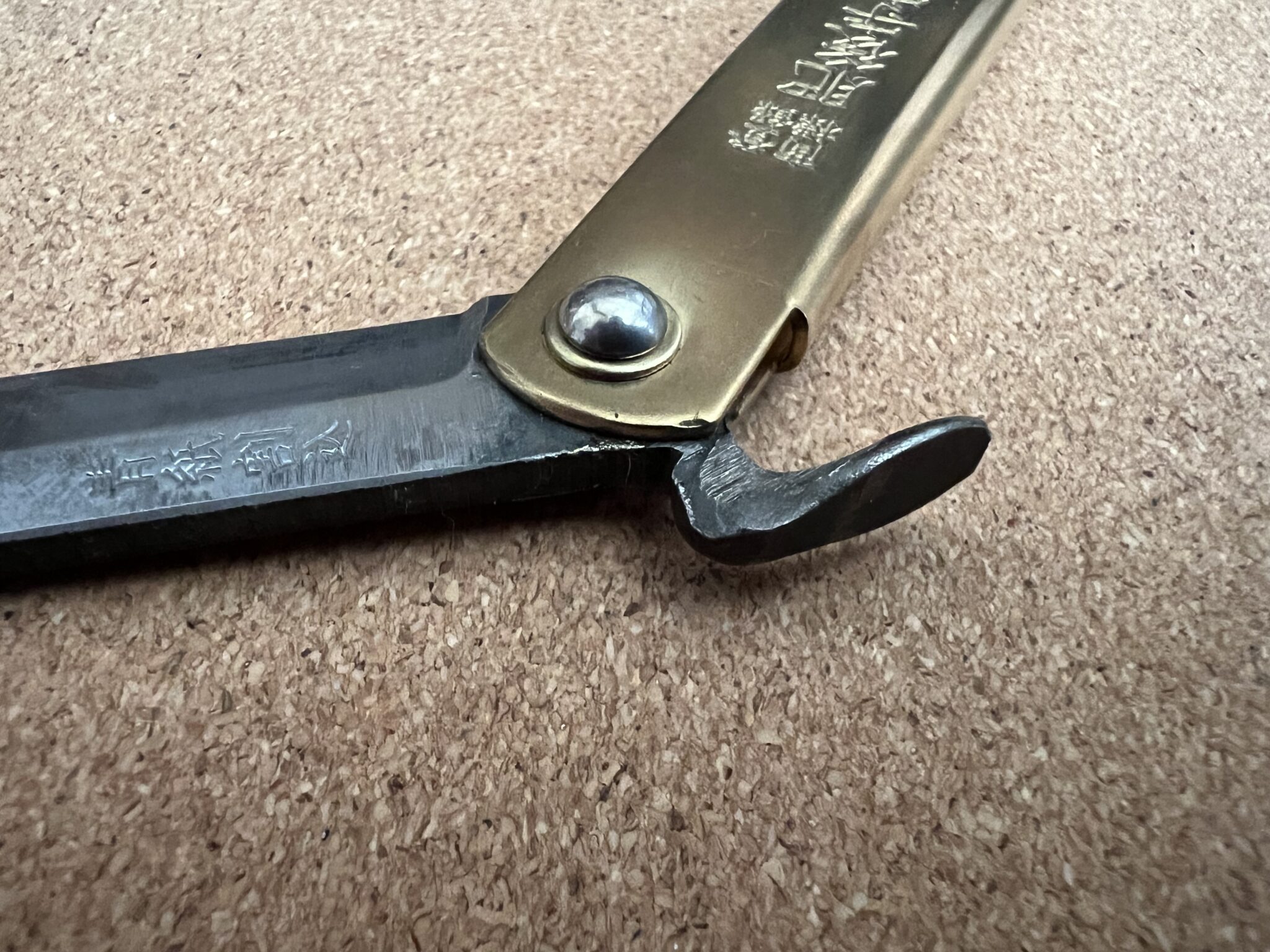
The blade is a “warikomi” sandwich of steel and iron which we in the West would commonly refer to as a “Scandi grind”. In other words, the edge is not bevelled–it tapers straight from the spine to the edge. This creates a slimmer blade profile which makes the Higonokami a slicing tour de force. It’s available in a few different steels but I prefer what they call “blue paper”, which is a high-carbon steel that is extraordinarily sharp, yet still very easy to sharpen. See more about the higonokami blade here.
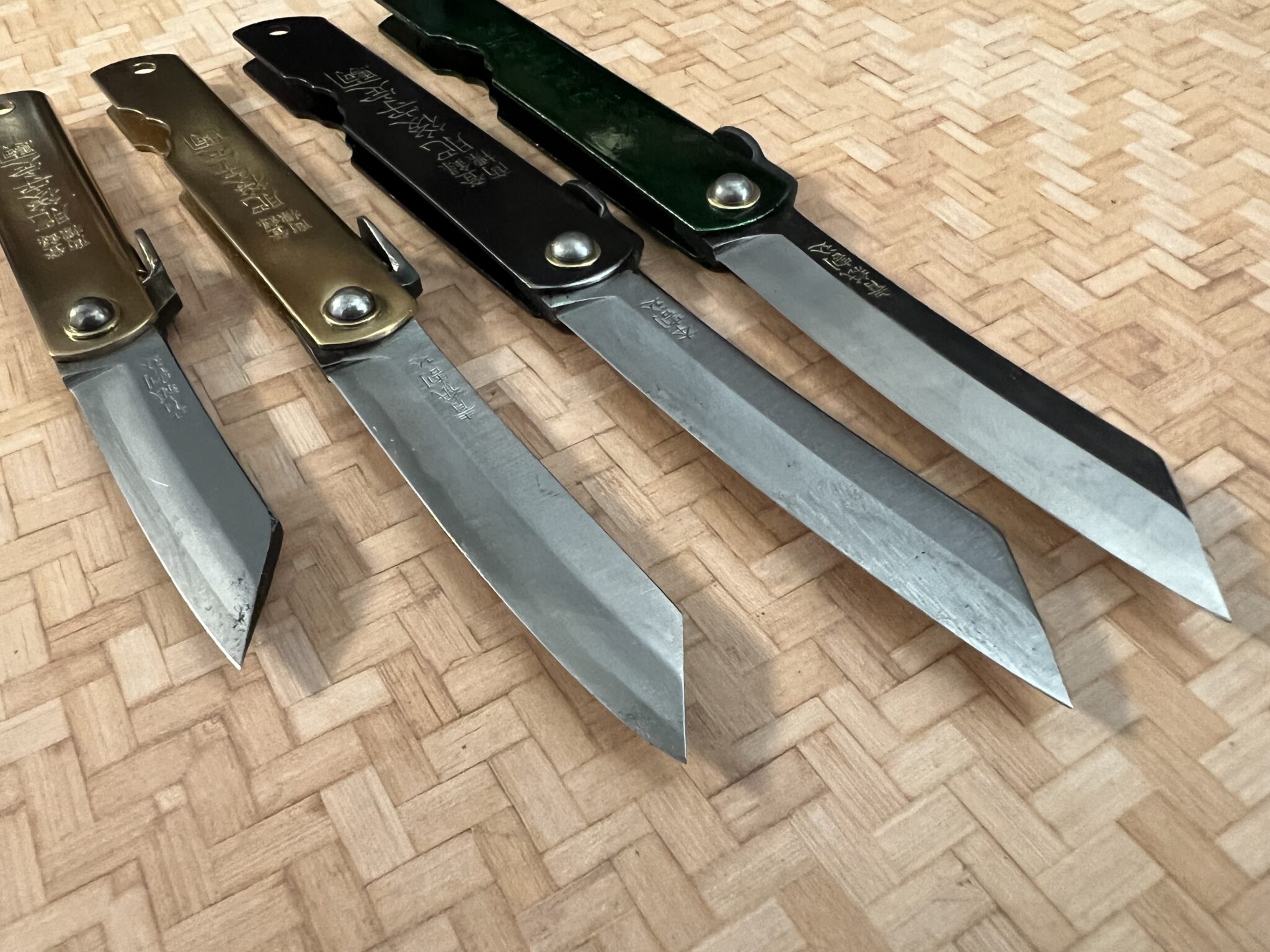
Here’s a video showing the construction process:
Sizes & Styles
The Higonokami comes in three sizes. The most popular is the 100mm, but they also make it in 75mm and 120mm. I own several in brass, stainless steel, and black, but tend to favor the 100mm brass because I feel it’s the most versatile size.
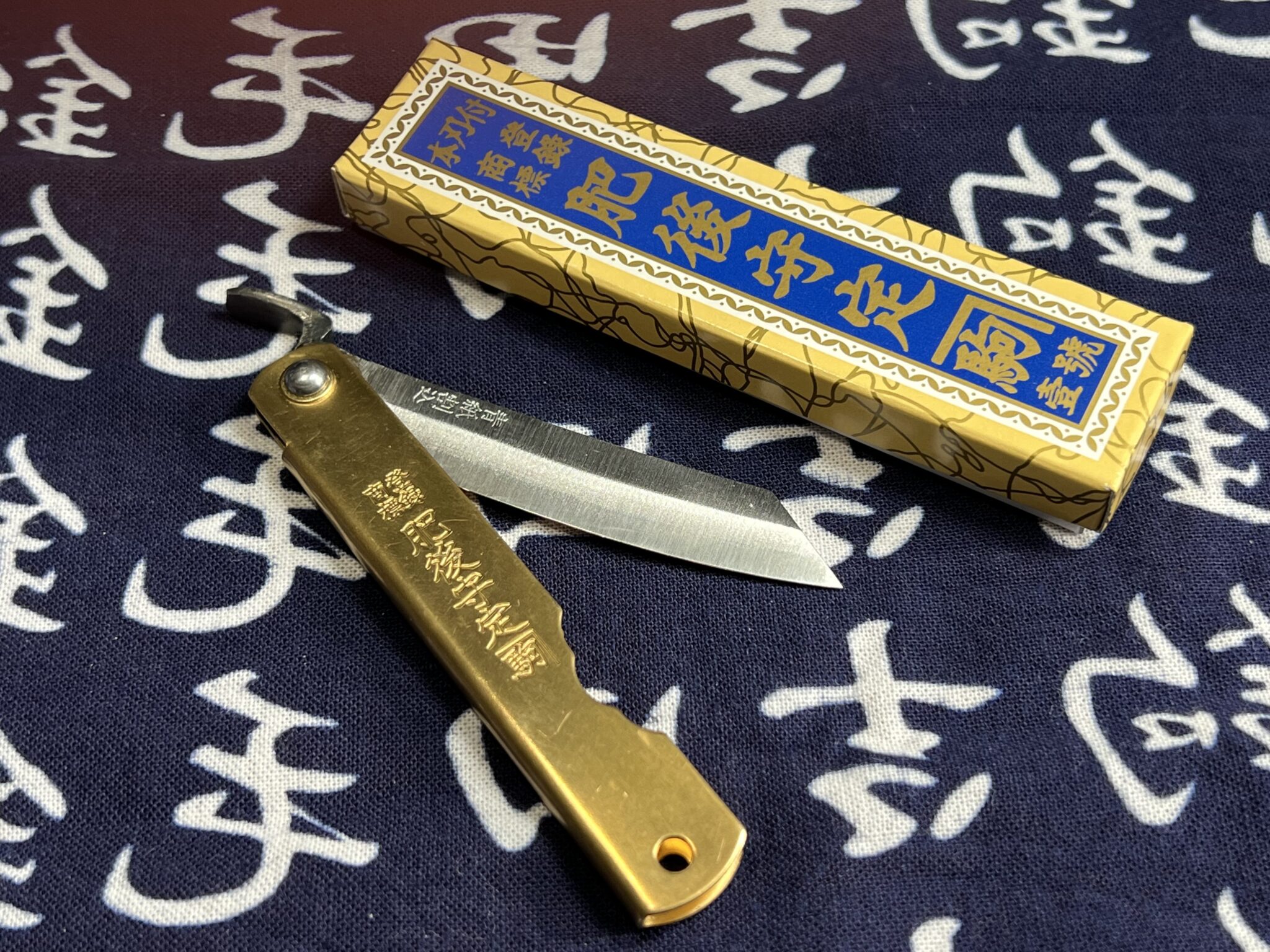 But I do carry the 75mm in my leather EDC pocket organizer/wallet along with a mini flashlight, pen, and cards. Aside from coming in handy when out and about, it’s great conversation starter if you learn a little of the history behind it. And if you need to do a small cutting task within the company of polite society, it’s much less intimidating to pull out a 75mm Higonokami than a 4″ Spyderco.
But I do carry the 75mm in my leather EDC pocket organizer/wallet along with a mini flashlight, pen, and cards. Aside from coming in handy when out and about, it’s great conversation starter if you learn a little of the history behind it. And if you need to do a small cutting task within the company of polite society, it’s much less intimidating to pull out a 75mm Higonokami than a 4″ Spyderco.
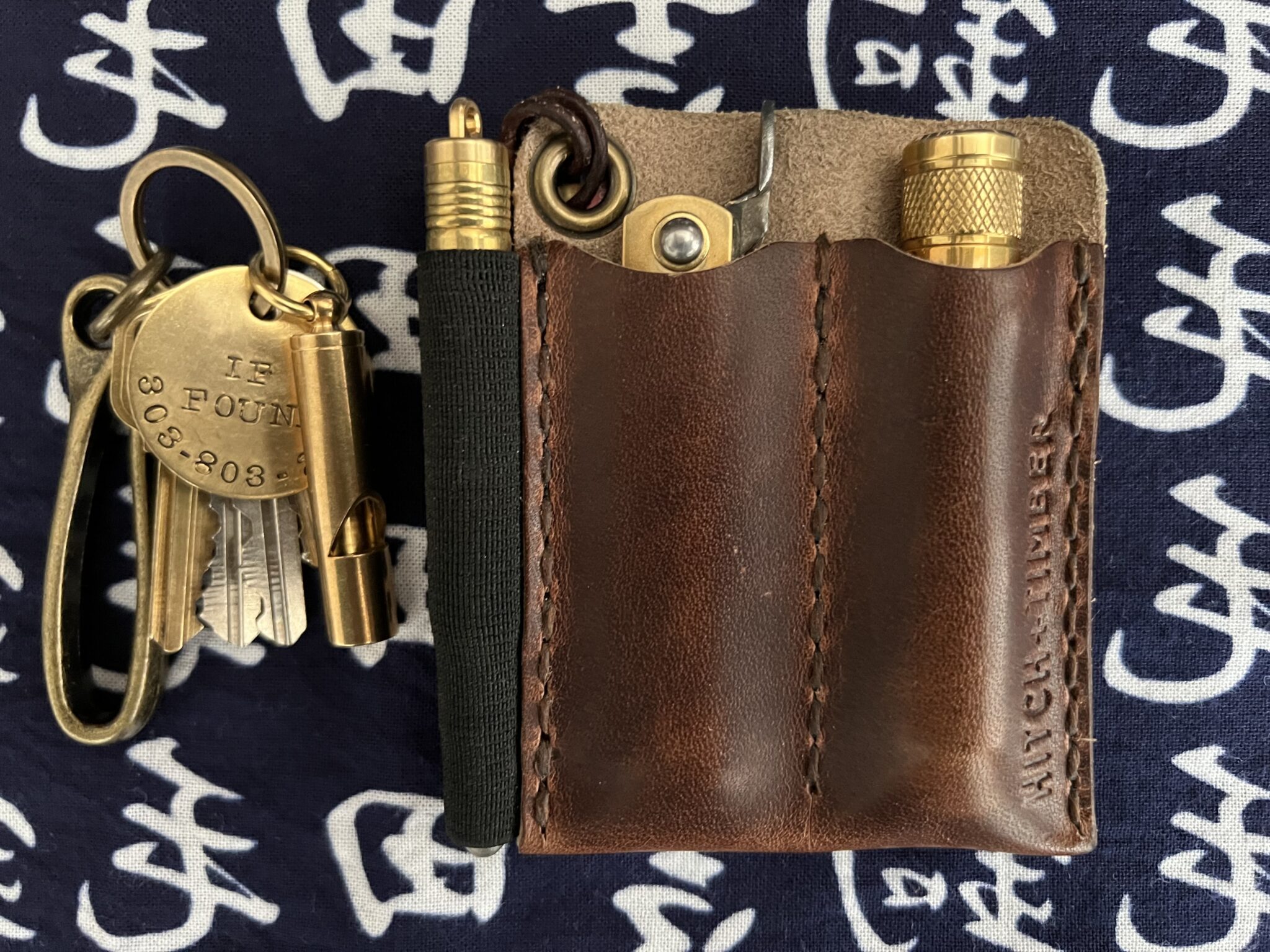
I also like the brass handled version because along with its carbon steel, it develops a gorgeous patina that compliments my other brass EDC gear well. Here’s a side-by-side of the 75mm and 100mm:
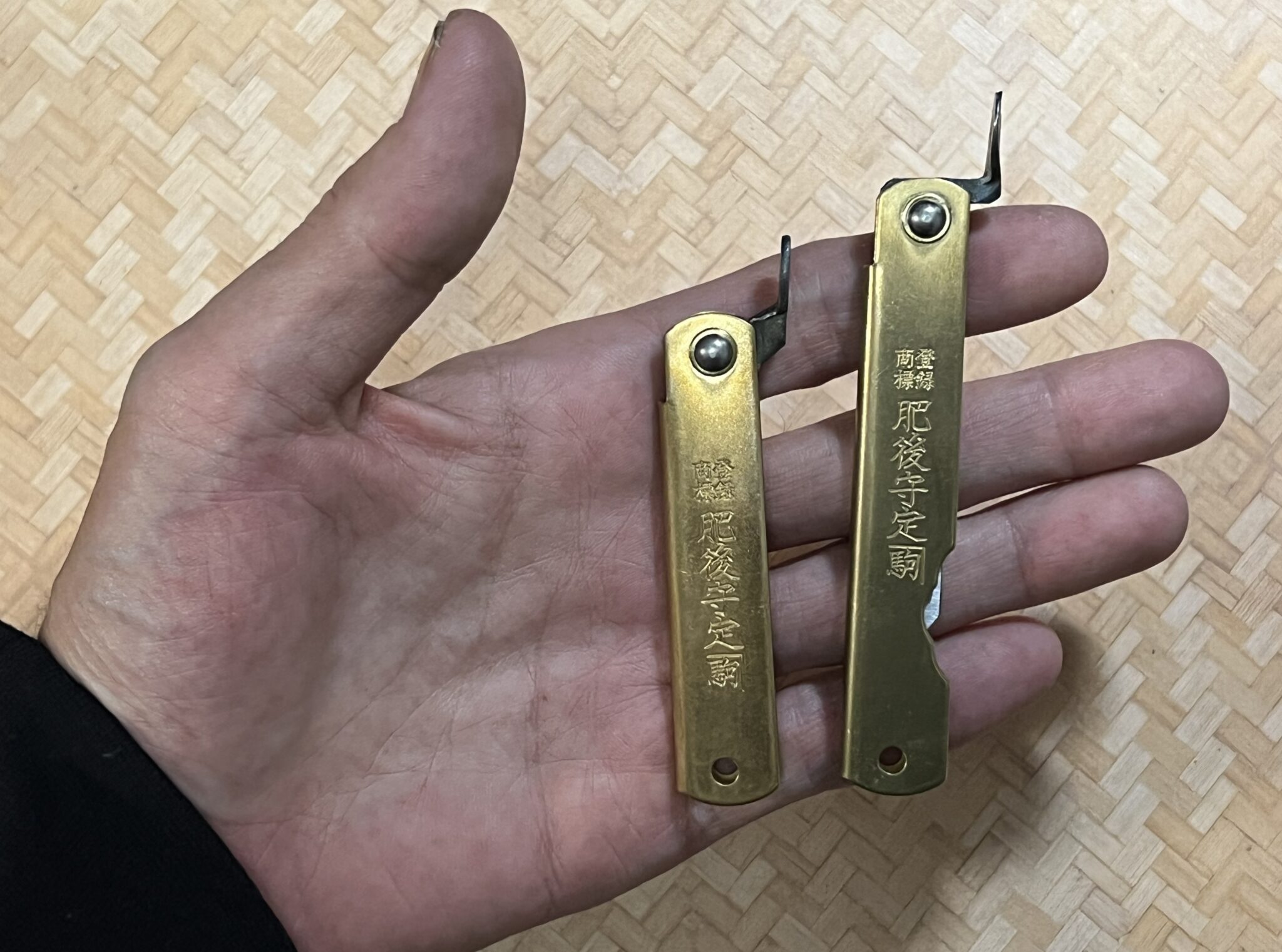
Some of the 75mm versions come with a little faux leather case so you can attach it to your keychain.
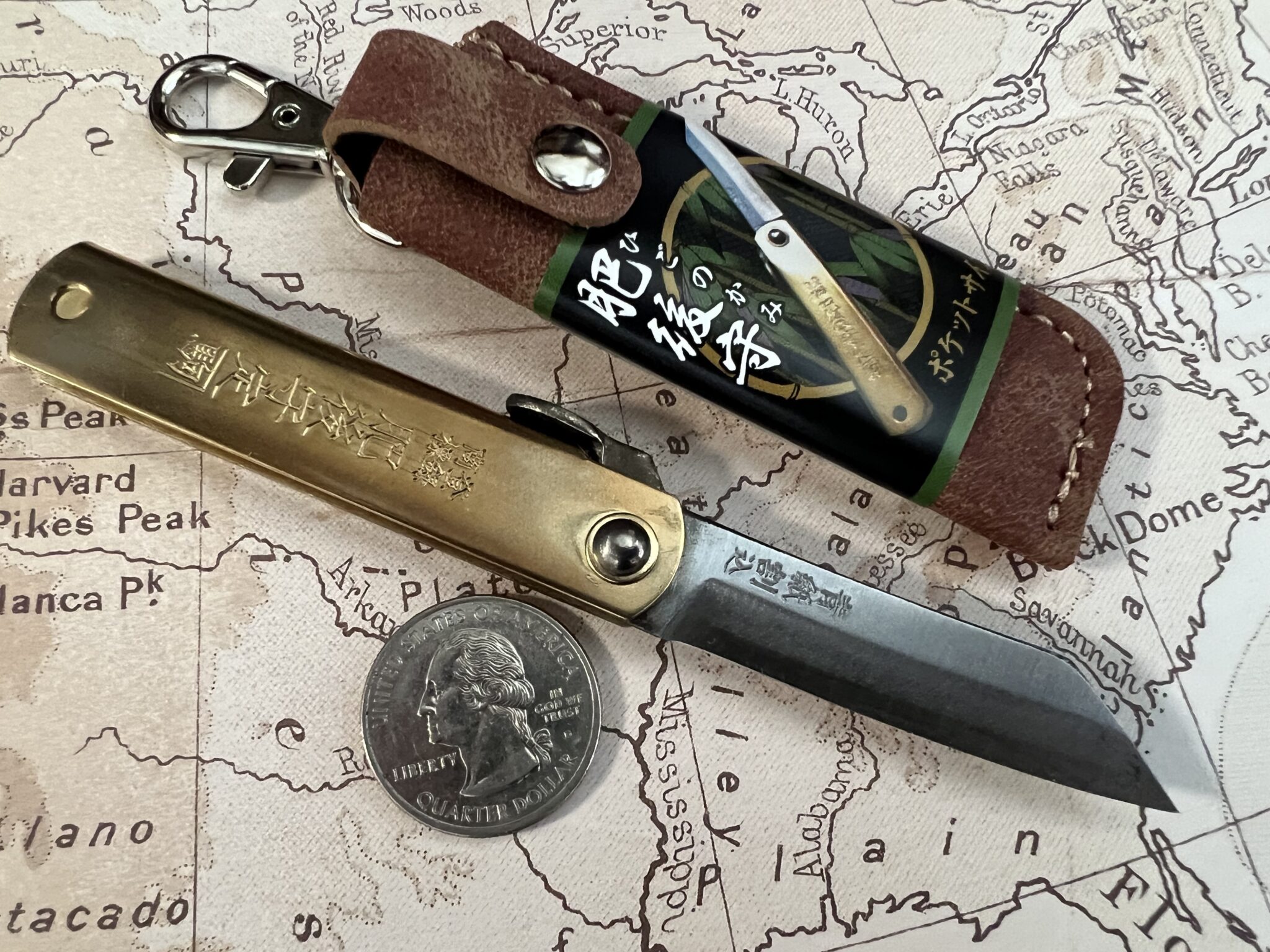
I even own a limited edition one in Jade that’s almost too beautiful to use!
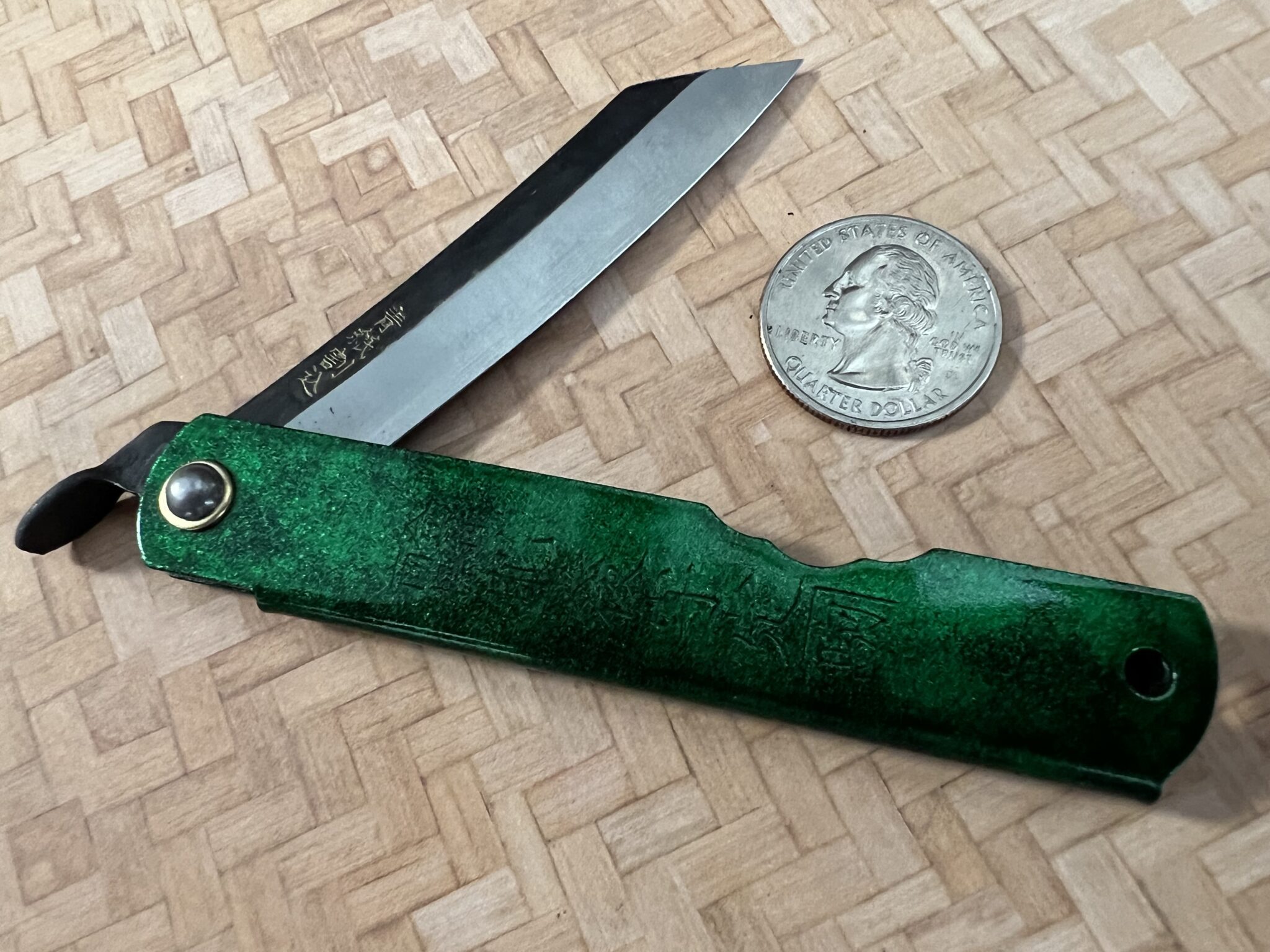
Here’s my entire collection at the moment:
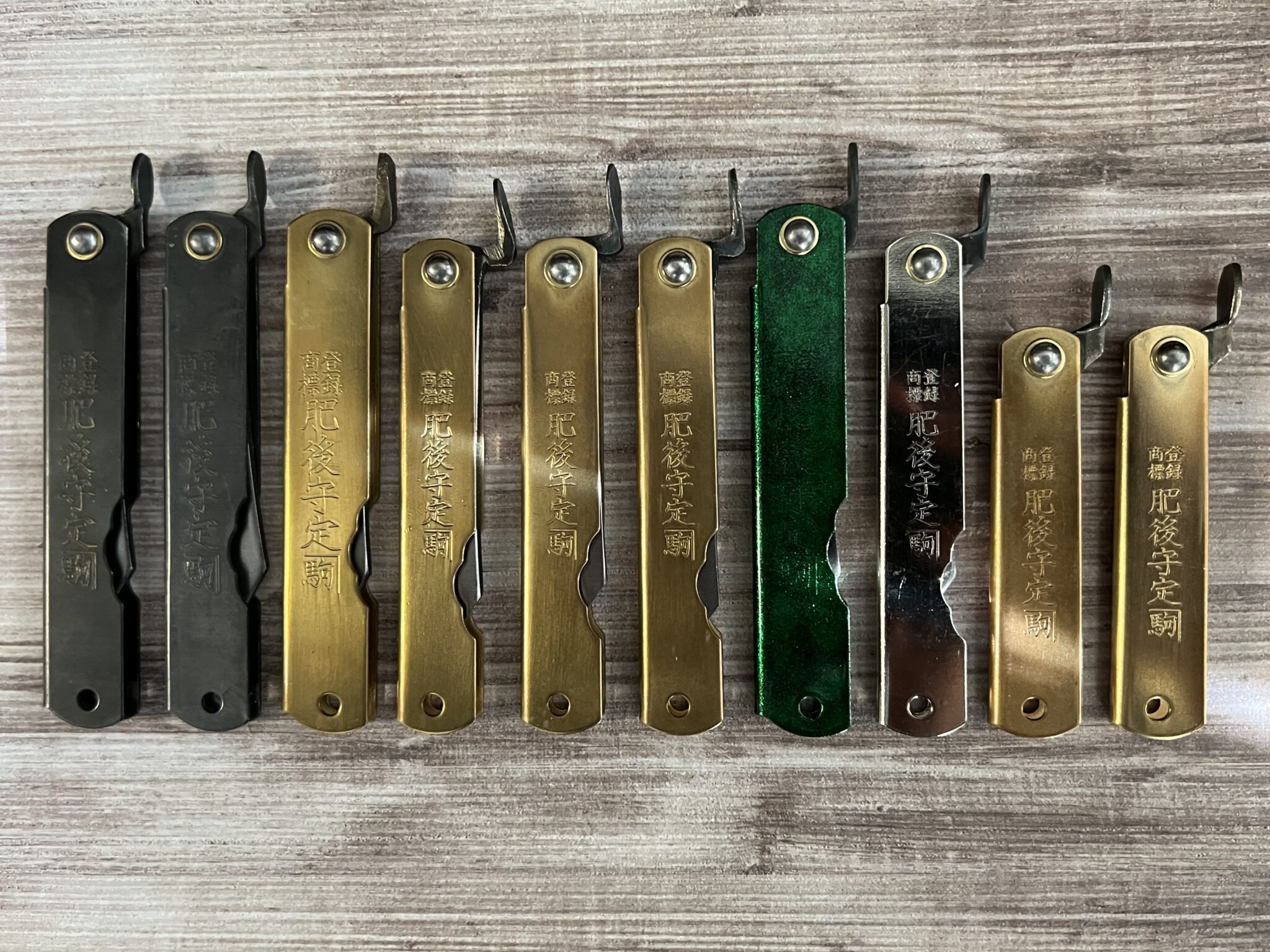
Multi-Purpose Design
I don’t know if this was intended or not, but I also use the little flipper as a mini pry bar. I intended to use it to open tins of pipe tobacco (I often smoke a pipe while I’m tying), but soon discovered it comes in handy a lot more than I thought: removing staples, opening keychain split-rings, lifting stubborn can tabs, scraping off labels, or any myriad of tasks around my desk that could benefit from prying. I think most tenkara anglers have an eye for design and would instantly recognize that this seemingly mundane little flipper is actually a very clever multi-purpose feature.
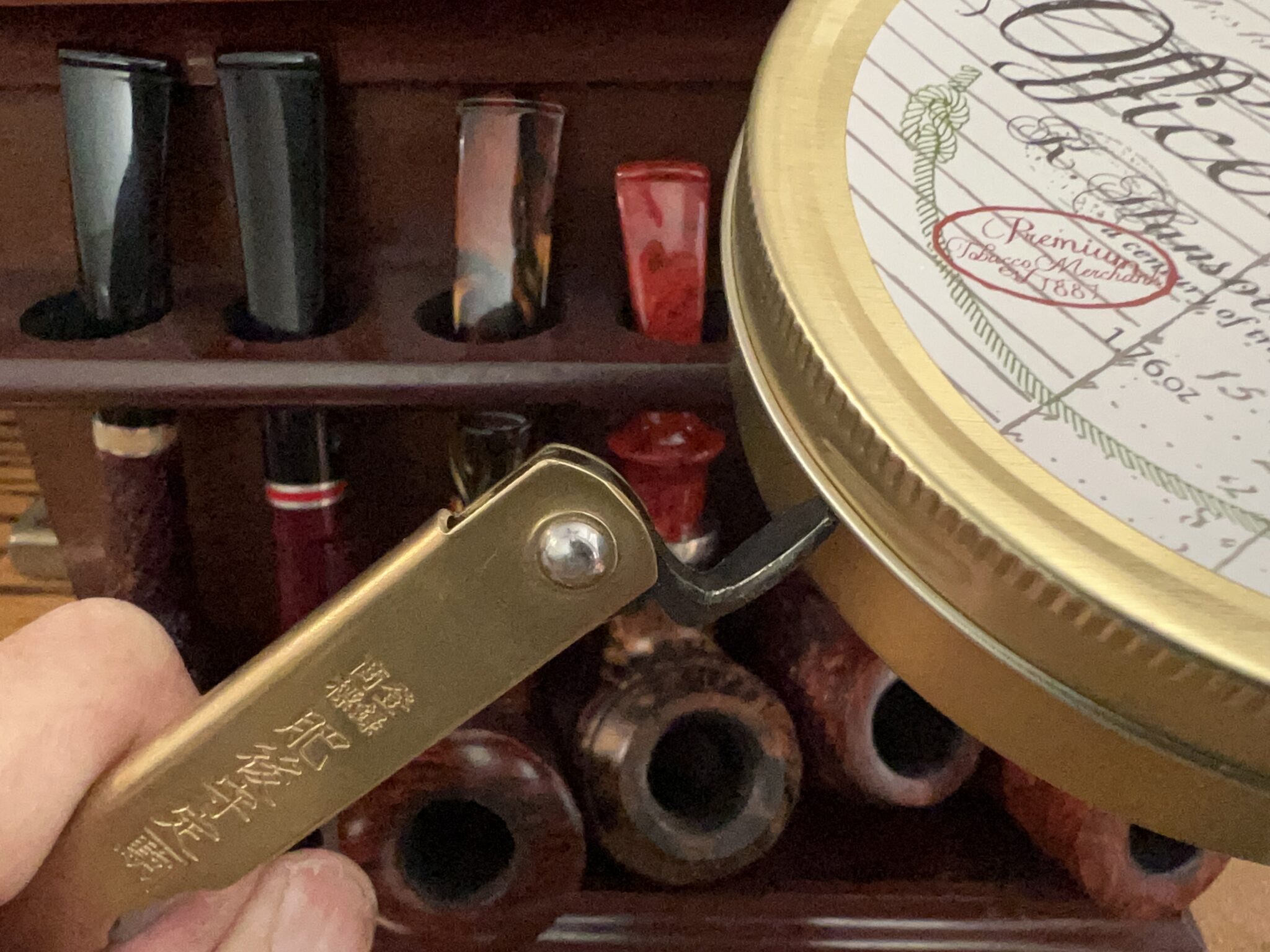
A word on the sizing … this is where it gets somewhat tricky. Since it’s 100% hand made, the length can vary due to anomalies in both materials and the construction process. And to make it even more confusing, some sellers refer to the blade length, while others measure the length of the closed size (including the little flipper). The latter seems to be more common, so that is measurement I use. Still, just like the stated length of most tenkara rods, don’t expect the measurements to be totally accurate–a 100mm is not exactly 100mm and a 120mm is not exactly 120mm. But if you have a wabi-sabi state of mind, the inconsistencies just make each knife even more unique.
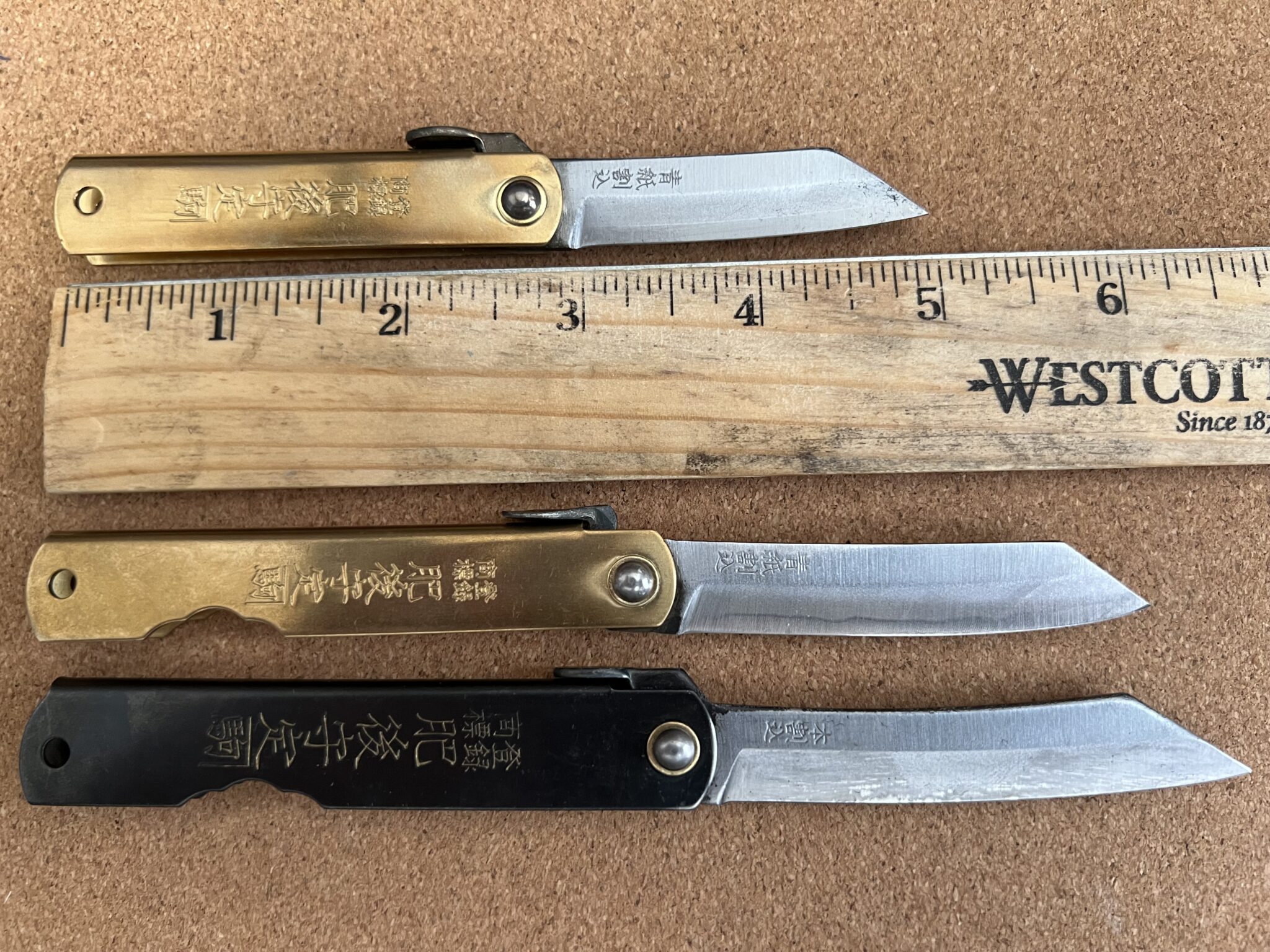
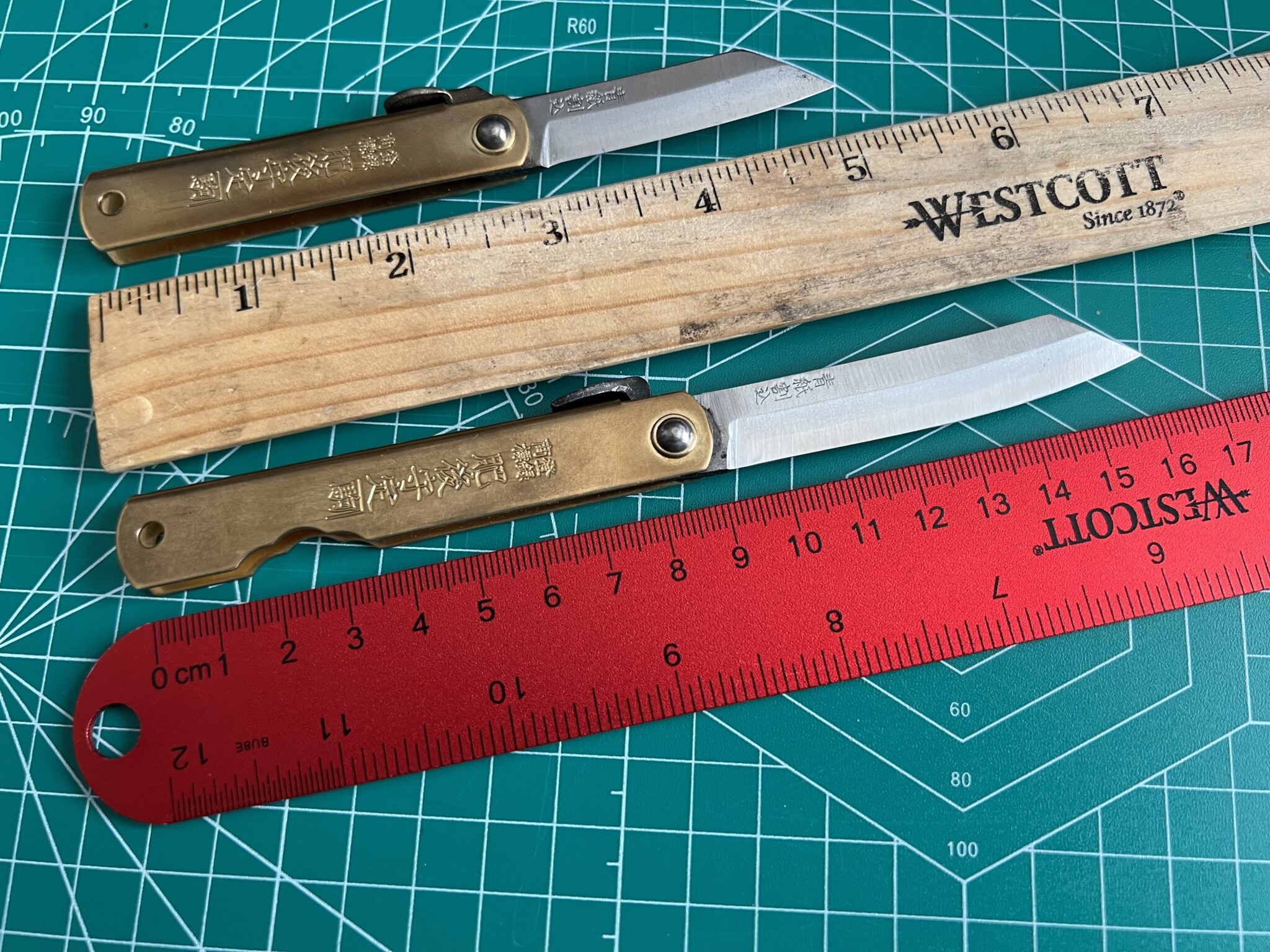
And just like the sizing, the weight can also be a little inconsistent. For example, in my collection, the 100mm knives can vary anywhere between 1.4 oz. to 1.7 oz.–even for the same model in the same material.
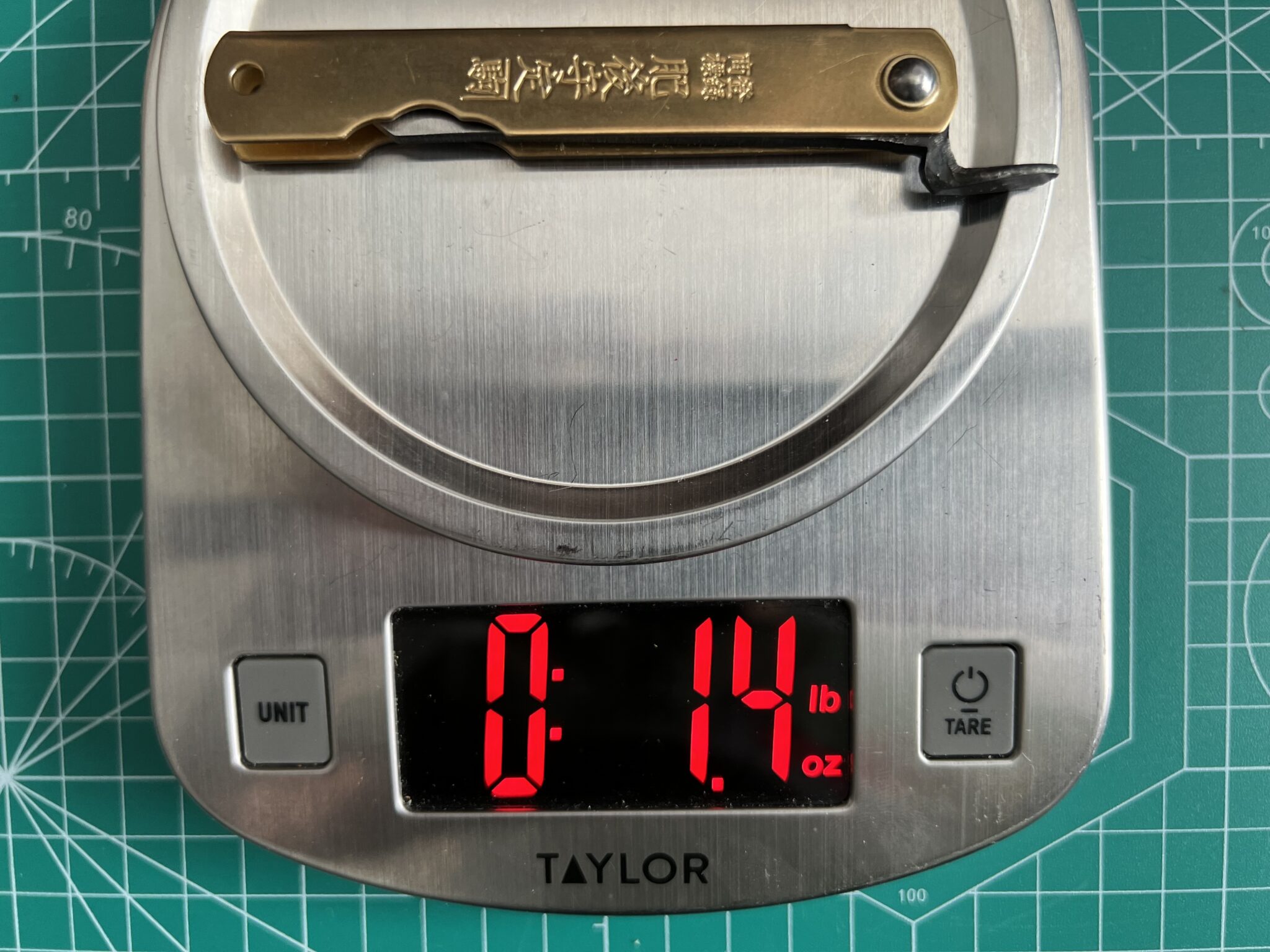
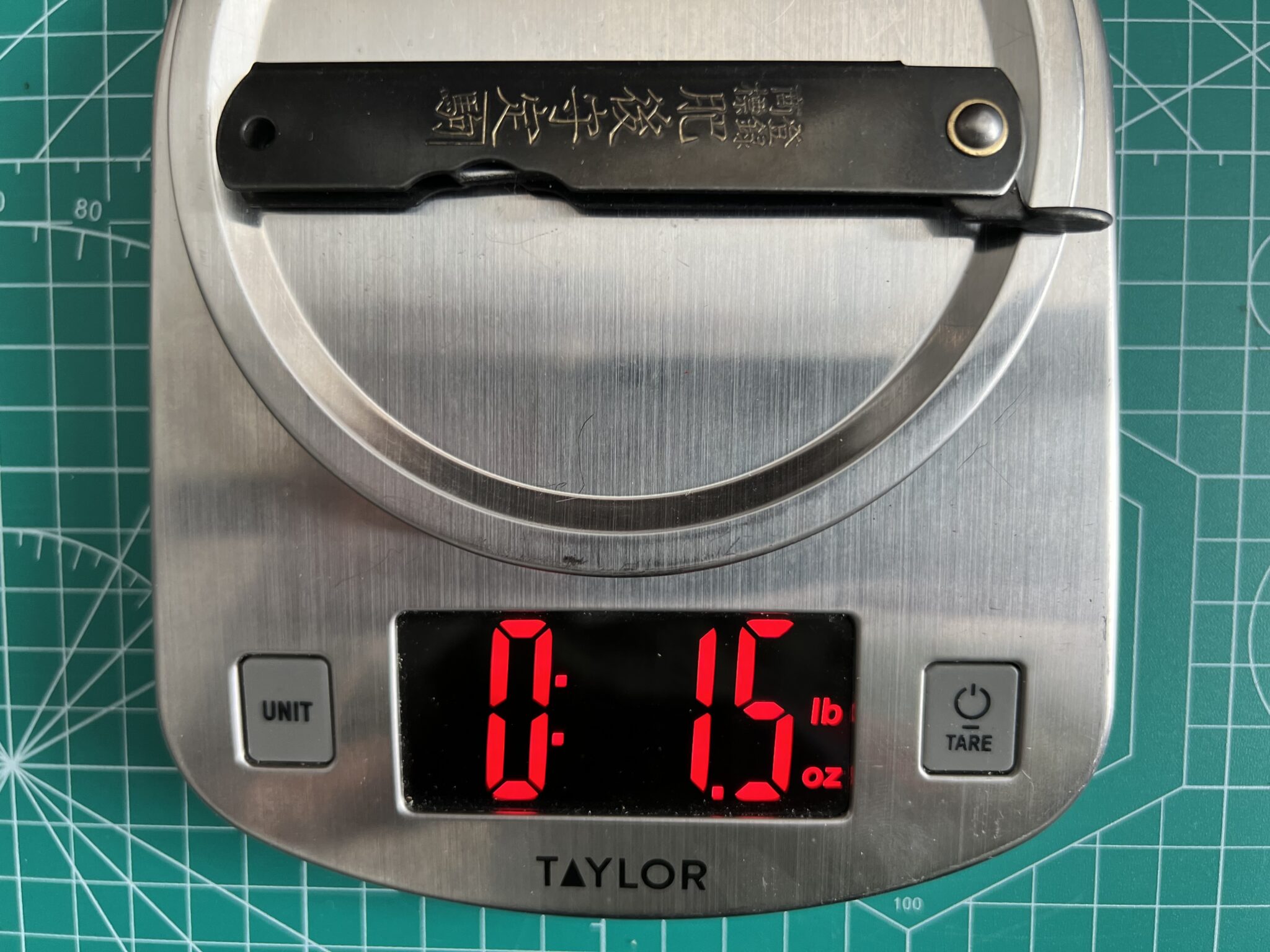
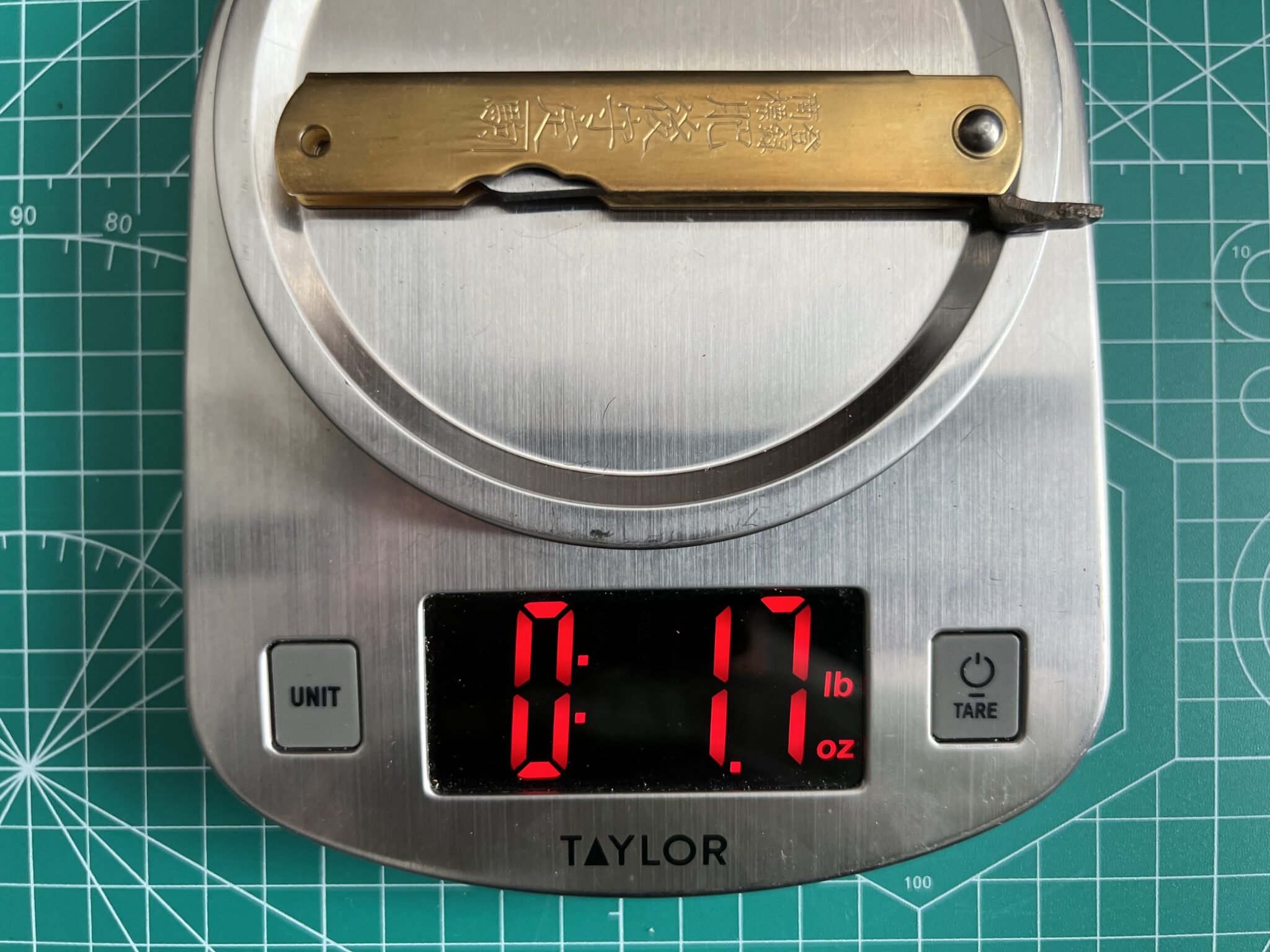 It might seem a tad heavy for such a diminutive knife, but for my application, weight is not a factor. I’m using it for EDC, not ultralight backpacking where “every ounce counts”. Plus, I like the reassuring feel of holding a solid brass knife in my hand.
It might seem a tad heavy for such a diminutive knife, but for my application, weight is not a factor. I’m using it for EDC, not ultralight backpacking where “every ounce counts”. Plus, I like the reassuring feel of holding a solid brass knife in my hand.
In case you’re wondering what the handle and the blade say, I haven’t bothered to get the translation, but I know it is stamped with the name of the maker and the type of steel used (VG-10, D2, etc.).
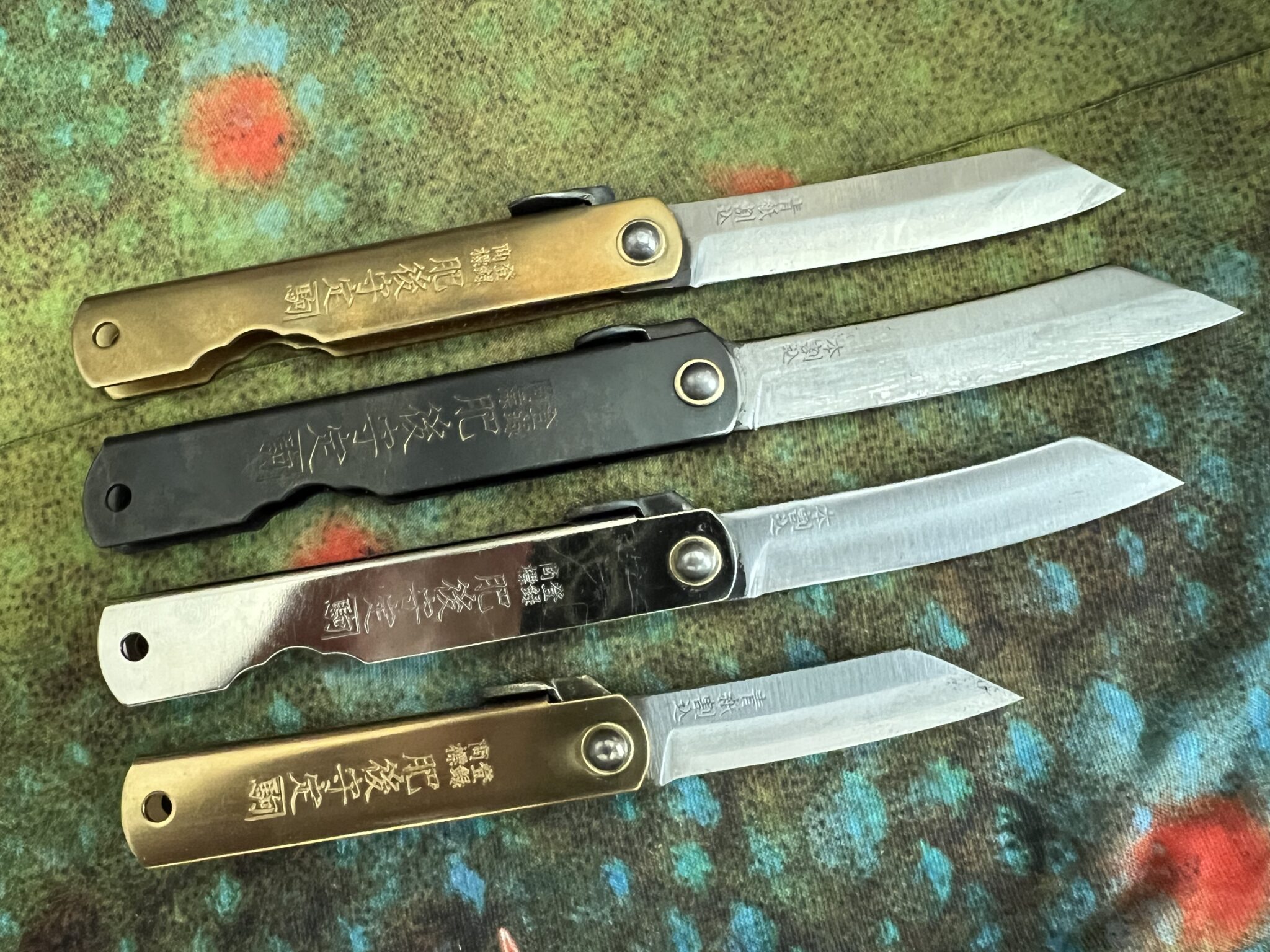
History and Lore
The best inventions always have an interesting story behind them. The history of this knife is fascinating and I urge you to spend some time Googling the backstory. I don’t have space here to give it justice, but here’s a little appetizer …
The first knives were invented by Komataro Nagao–some say some say in 1894, while others say 1896, but either way, it was born some time in the Meiji Era after the samurai were decommissioned.
The name “Higonokami” (means “lord/god” of Higo, the old name of the Kumamoto area in modern-day Kyushu. Ironically, “Higonokami” was also an honorific title given to samurai. But the knife actually got its moniker from a hardware wholesaler who carried Nagao-sans’s knives and thought such a name would increase sales since many of his customers were from Higo. And it did.
The knives became so popular in Japan that at one point, all schoolchildren were issued one to use as a pencil sharpener. That, like many other of the old ways ceased when modern inventions such as the mechanical pencil sharpener were being ushered in during the Meiji Resotration
Then, shortly after the turn of the century, it gained another lift in popularity when its design was said to have been admired by the prince who would eventually go on to become Emperor Taisho.
Five generations later, Higonokami are still handmade today by Komataro-san’s descendant Mitsuo Nagao at the Nagao Kanekoma Factory in Miki City. It’s said that Mitsu-san still makes each knife personally, producing over 2,000 annually. Either this is an exaggeration, or another interesting addition to the Higonokami’s lore.
If you search online for “Higonokami Knife”, you’ll get a good day’s worth of interesting reading. The backstory is too vast for me to cover but I think you’ll find it’s worth spending a little time investigating–especially if you’re planning on buying one so you can entertain your company with trivia every time you pull it out.Here are just a few links toto get started if you’re interested:
https://www.higonokami.jp/en/history.htm
https://www.japaneseknives.eu/c-2495966/information-on-higonokami/
https://www.higonokami.jp/en/pg143866.html
Authenticity
Earlier, I mentioned the term “higo”. This is used for any knife that employs a similar flipper mechanism but that doesn’t mean it’s a genuine Higonokami made by Nagao-san at the Kanekoma Factory. To combat knock-offs, the design was trademarked in 1910 and today, the way to tell if it’s authentic is if it comes in a box with a blue label like these:
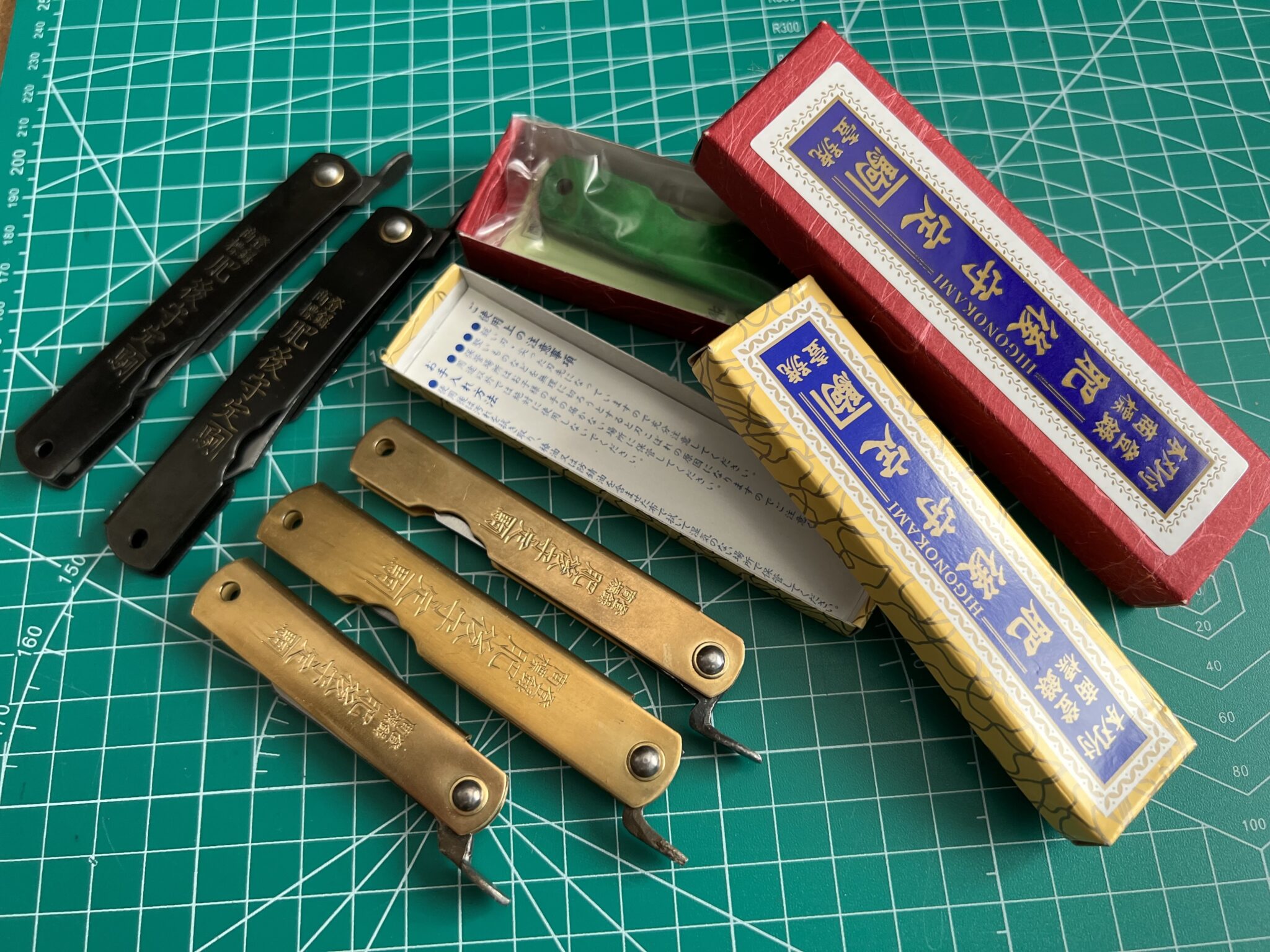
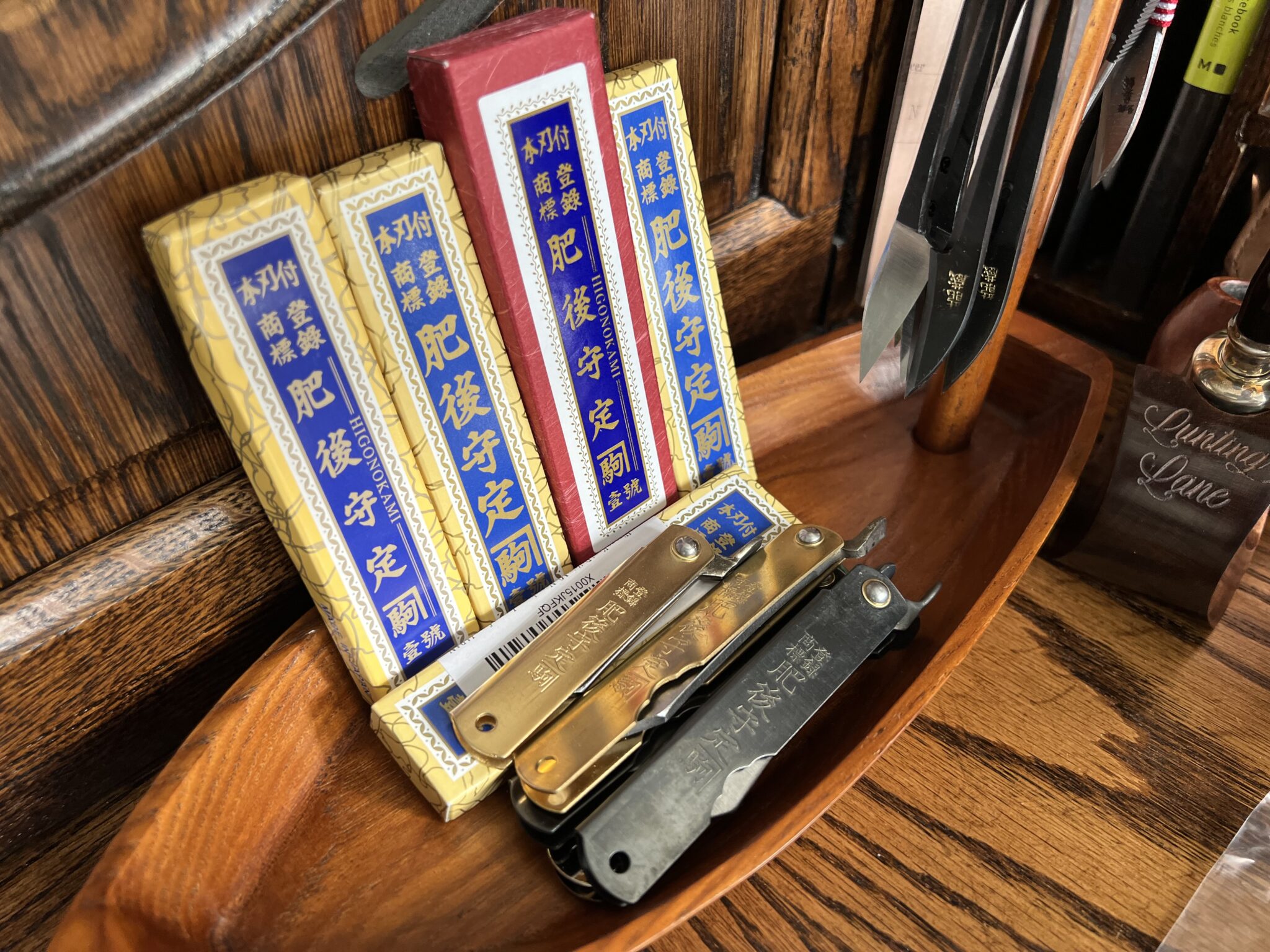
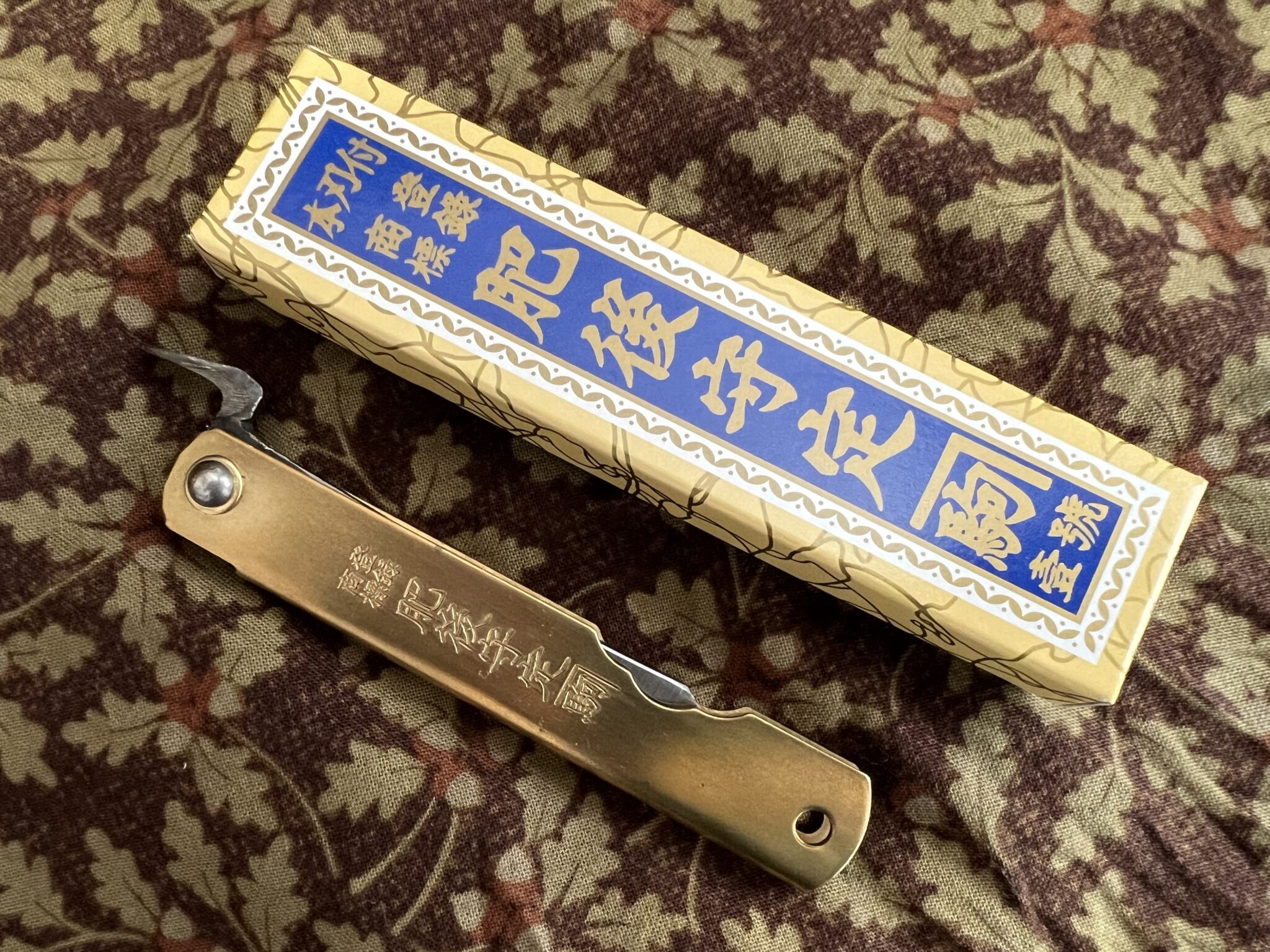
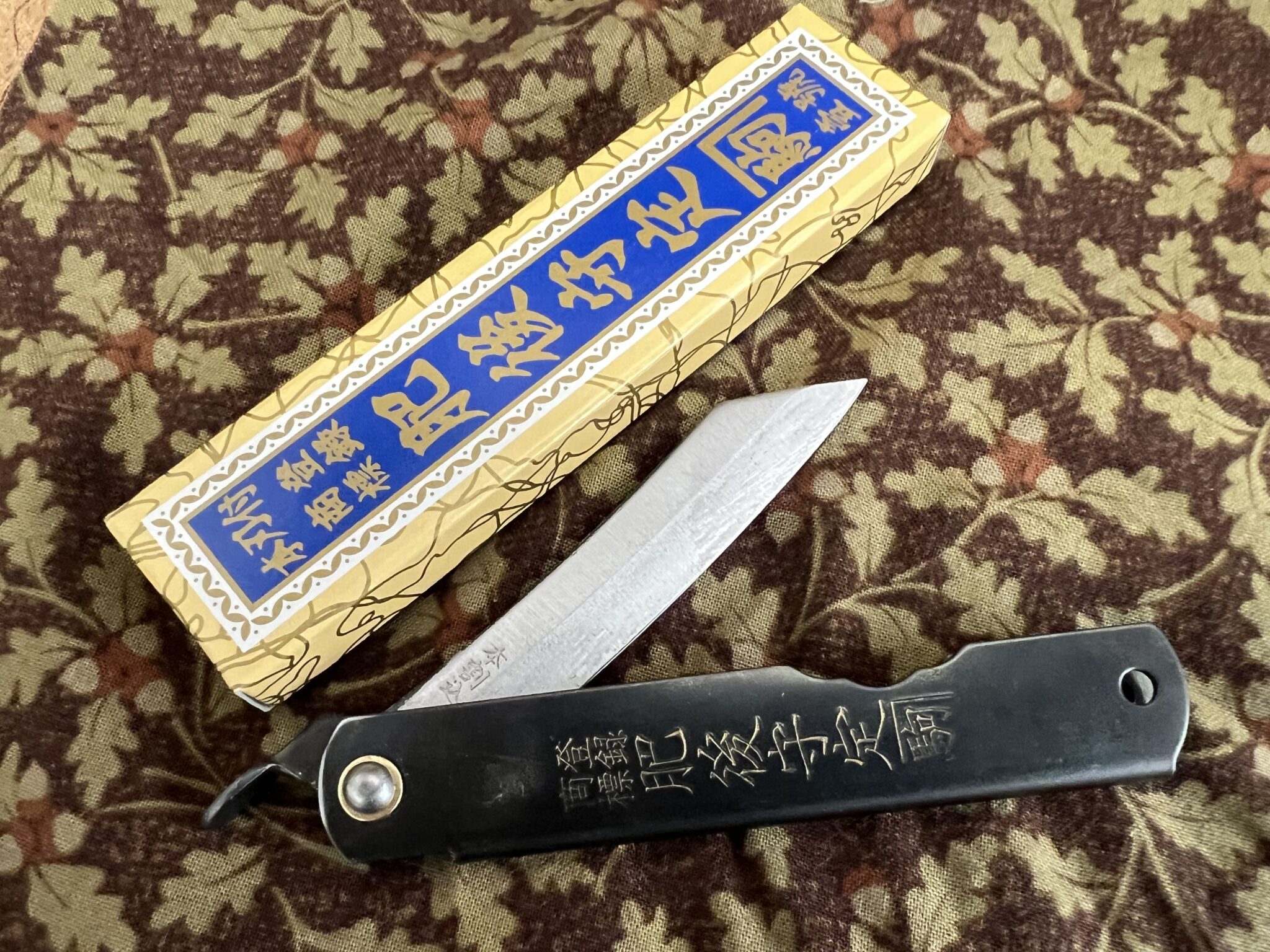
Uses
Knives have a 1,000 uses. I use my Higonokami at the tying desk for cutting all manner of materials that I might not want to punish my more expensive blades with. But where it really shines is opening packages and mail (which I do several times a day). In the field, it’s great for carving up food for shore lunch, cutting line and tangles (to save your clipper blades), etc. Plus, don’t forget the multi-use flipper! And being so compact, it takes up almost no space in even the the most minimalistic packs.
Price & Where to get Yours
Again, like tenkara gear, Higonokami are relatively cheap (some would consider disposable) and given their quality, the value is very attractive. You can easily find them online with the usual suspects:
Overall, Amazon seems to be the best in terms of stock, selection, price, and shipping. I’ve paid anywhere from $11 to $40 but the typical price for a 100mm is typically around $15 (that 75mm above with the case was $36). There are some limited editions that cost upwards of $100, but to me, the humble $15 100mm brass is beautiful enough (Not to mention that I can buy 10 of them for the price of one limited edition :))
What about sharpening?
I haven’t had to sharpen any of mine yet, but they take an edge very easily because of the high-carbon steel. Here’s a good video that shows how easy they are to sharpen (even for an amateur):
In this age of mass production, computer automation, and 3-D printing, it’s a welcome thing to find there’s still a place for old-world craftsmanship and heirloom quality in modern society.
As with so many things in tenkara, the Higonokami is simple, utilitarian, and quirky, but has a certain understated dignity and beauty to it. Being so compact, it’s easy to carry anywhere and embraces the tenkara philosophy of minimalism in form and function. Like Picasso wielding his Opinel to create sculpture, I believe the tools we use to pursue our craft should reflect its beauty and ethos. And the Higonokami embodies the core values of tenkara better than any knife I know.




Jason:
Great article. Being a casual knife collector and Tenkara fisher I had to have one. Just ordered the real deal. Thanks so much for the info.
Regards, Steve
Thanks Steve! Please let us know who you like it and what you find yourself using it for.
I went to the website but I did not see how to order one. How do I do that?
That is just the factory website. Just search for it on Amazon or eBay. There are lots of them!
I received my Higonokami this morning and I have to say that for a knife at this price point I am very impressed. While I’ve carried a Swiss Army knife in my pockets for over 50 years, and a folding tactical knife on my belt, I’m carrying the Higonokami in the Tenkara chest pack. It will be much easier to access with waders on than the two mentioned above. Thanks Jason for bringing these great little knife to our attention
Steve
Beautiful looking knives. Where did you order from?
Amazon is the best for the common ones like mine. eBay is OK too but Amazon seems to be better in price, selection, and shipping speed. If you want one of the limited edition ones, you’ll have to search some of the Japanese knife sites.
I ordered mine from Ebay and made sure it was from the correct manufacturer (as Jason said in the article) by making sure the seller included a photo of the box.
Looks like a really cool knife, but if the blade does not lock in place, how easy is it to fold back on your finger?
Hi Mike, did you read the part about placing your thumb on the flipper to stop it from closing? I talk about it in the article.
Nice, but won’t replace my Benchmades!
It’s not meant to! I also always carry a larger folder like Spyderco or CIVI with me anyway.
Thanks, I learned something new today. I really appreciate the simplicity and practicality of them. I have a couple of Opinel but the blades are nowhere as beefy. Having some weight to them is a big plus.
I think I will keep in my fishing jacket, a basic Swiss Army knife with its couple blades, tweezers, scissors, screwdriver, etc. all in one. AND the blade stays open = a good thing since I keep it razor sharp with stropping.
Hey Gary, well, the SAK doesn’t have a locking mechanism either, so there really isn’t much of a difference. In fact, the Higonokami might even be a little safer since you are putting pressure on the flipper to keep it from closing.
At any rate, you just reminded me of something. I need a strop. I have whetstones, ceramic rods, diamond sharpeners, etc.. but I don’t have a strop. Can you recommend a good one?
Great article thanks! What type of scissors do you use on your desk. They look nice as well.
Hi Nicholas, Thanks! I have a post on scissors coming very soon.
I may be stupid but I got on the website and couldn’t figure out how to order??
Hi Justin, That link is merely for reference. I say in the article you can find them easily online. Just search for it on Amazon. I don’t like to put direct links to sites like eBay and Amazon because the links are temporary and I do want to end up managing tons dead links for hundreds of articles. Good luck. You’ll find them no problem. Let us know how you like it (or don’t).
Amazon
eBay
Google Shopping
I’ve had several in my lifetime. My first one was back in the early 50’s. I remember cutting myself often as they can be quite sharp. My EDC these days are either a Benchmade or a Pro Tech but I always keep one in my desk at home. There’s something about a handmade knife that lets you connect to the person that created it.
Nice to hear from someone who gets it! Don’t get me wrong … I love my Spydercos. But they’ll never have the charm or uniqueness of a hand-crafted higonokami. Plus, I’m a sucker for brass. 🙂
Been carrying one for years. Most practical knife on the planet. Also have one
in the office to open mail. If you don’t have one, get one immediately.
You will be 100% pleased. Did I mention razor sharp?
All of the pictures are of the same side of the knife. Isn’t that interesting? Not one pic of the open knife from the other side.
Because the other side is boring–no kanji or anything.
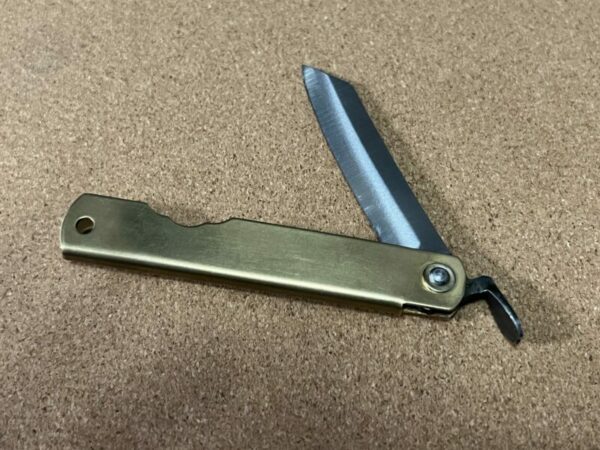
I was a little surprised you didn’t mention the legality of a Japanese knife in Japan. I accidentally forgot to check my Gerber Paraframe Mini with a 2.2″ blade on my way out of Tokyo. Security whipped out a small ruler, measured, and nodded, but kept the knife since I couldn’t take it on the plane and I didn’t have time to check it. I was never able to see a consistent number, but I think it is 2.5″ and below before you’re committing a crime.
Hi Chris, why would I? I don’t live in Japan and it’s irrelevant to most of my readers. Not every article can cover every single point. I mean, if I talked about the carry laws in Japan, then what about the laws in every other country? Someone will then say, “why didn’t you mention the carry laws in Germany?” Then what about Switzerland, Canada, South Africa, etc…. Anyway, legality of knives in Japan is beyond the scope of this article. It’s simply about the knife and why I like it and what I use if for. People are responsible for looking up the laws in their respective countries. The onus is not on me.
You seemed to do a lot of research on it, so I wouldn’t have been surprised if you came across the legality of a Japanese knife in Japan. At any rate, two of the 3 sizes you listed, at least, are illegal to carry there, so it casts doubt on any authenticity. So, are these Japanese-style knives, then?
How would German carry laws Conte up regarding a Japanese knife in an American article? Japanese law at least makes for a Japanese knife
Chris, I was aware of it and as I said, made a conscious effort not to include it since it’s irrelevant to the article. As for “authenticity”, that logic doesn’t follow. For example, I can legally buy an 8″ knife that’s made in the U.S.A. But it’s illegal to carry an 8″ knife around in the U.S.A. Would you then be suspicious that the knife was really American-made?
Anyway, I’m not really interested in pursuing this. You can nitpick about things like authenticity all you want. I know they’re authentic and really don’t care if you or others use them or not. I was just sharing because I think they’re good knives that have gained popularity for over a century for a reason and those who have them “get it”. They’re not for everyone. just like tenkara, you either get it or you don’t.
Wow, these are super nice. Great article!
What is your edc pouch that you pictured?
Hi Matthew, it’s a Hitch & Timber Runt 2.0. I also have their Duz-All organizer. I love their stuff! Here’s their website but they also have an Etsy Store: https://hitchandtimber.com/ He’s on hiatus right now and Idon’t know when he’ll be back but definitely check out their EDC stuff when they are.